#2019 gc january week 2
Text

Week 2′s Thursday prompt (I’m moving ahead because I have free time) is “Start a page for the deity or deities you worship, if you do...”
Since beginning my pagan path about thirteen years ago, I’ve worked with a number of deities: the Wiccan God and Goddess, Brighid, Cerridwen, The Morrigan, Gofannon the Smith, Manannan MacLir, etc. Usually, my working with them is brief. They seem to come into my life to offer a lesson and then disappear again into the mists.
Though I’ve worked with a number of gods and goddesses since beginning my path, two of them have remained with me throughout that time, taking up various masks before identifying themselves. It is a personal choice not to name them here, as my names for them are personal to my path.
The first is my Hunter God. He was known by me as Green Man when I first began my journey. For a time I thought him to be Herne the Hunter. He has been many things to me: forest guardian, bringer of vegetation, fearsome hunter, vampire, king of all that is dark untamable and wild, lover, mentor, face in the trees, leader of the Wylde Hunt, lord of fae... He appears to me either: clad in tartans and furs, woad paint over a scarred physique, hair in braids, horned and wearing a cloak of dark feathers; or as a shadowy trickster, all darkness and finery, thin lips over sharp teeth, dark eyes that watch your pulse and every nervous movement. The latter is rarer- usually when he has some harsher lesson to bring forth. On my altar, I have statues of horned figures and collections of feathers, bones, bits of wood and things from the forests. I leave him offerings of wine or ale and poetry. I dedicate my archery practice, my drumming, and my walks in the woods to him and listen for his hounds and horn from the northwest.
The second is my moon goddess, Lady of the Lantern. For a summer, I struggled to identify her, finding traces of her in the stories of Hel, Arianrhod, Cerridwen, Persephone- and yet, she was none of those goddesses. She appears to me clad in deep starry blues and silver. She bears a blue lantern and a scythe made of a birch branch and a shining silver crescent moon. I have long held a fascination with the moon and stars, and had a difficult time connecting with a goddess as I did my Hunter God. Recently she has come to me: a washer at the ford, a light in the darkness, mother of death, strange, mysterious, beautiful and half shrouded. On her side of my altar I have a blue lantern to mimic the one she carries. I leave offerings of star-like crystals, black feathers, and candle light. She has been my guiding light through some very troubling times since graduating.
#2019 gc week 2#2019 grimoire challenge week 2#2019 grimoire challenge#january week 2#2019 gc january week 2#pagan#pagan gods#druidry#witchcraft#personal gnosis#wylde hunt#moon goddess#hunter god#horned god#personal path#personal deities#devotional paganism#lady of the lantern#forest god#star goddess
35 notes
·
View notes
Text
interview tag game!
tagged by: @nctsworld
tagging: @sehunniepot @smoll-tangerine @jeongvision @jaedore @lebrookestore @danishmiilk @ncteaxhoe and everyone else who wants to! i’ve completely blanked out it’s like 5am pls bear with me
name: alexa (alex for short wink wonk)
pronouns: she/her/hers
star sign: pisces
height: 5’7 (i finally checked after a doctor’s appointment — i am indeed 5′7)
time: rn... 5:02 am EST
birthday: march 12 uwu
nationality: filipino-canadian
favorite bands/groups: bts, nct, exo, red velvet, epik high, the whole dpr gang gang, uhHHhhh i suddenly cannot think dkjhfskdjh but honestly i listen to everything except country music so that should explain a lot
favorite solo artists: oof if we’re talking s.k soloists: iu, chungha, sunmi, hyuna, jessi, SAM KIM, and a LOT of khh and krnb artists but if we’re talking like outside of s.k solosists: jacob collier, daniel caesar, sza, kiana lede, frank ocean, H.E.R, the weeknd, rex orange county, and there’s just... a lot to unpack so i hope this shows you what kind of music i’m generally into
song stuck in your head: telepatía by kali uchis
last movie you watched: one week friends! sighs kento yamazaki... what a refined man
last show you watched: idk probably some filipino drama but listen filipino dramas are on some next level intense family drama shit and it really just shoots your blood pressure up so ever since then i’ve just.. no <3 ALSO now that i think about it, the last legitimate show i watched was probably alice in borderland which was in december-january kjsdhfkjshd so it’s been a while
when i created my blog: oof december 2019 it’s been 2 years
last thing i googled: i shit you not... it was ‘skrrrt corvette corvette’ don’t come at me
other blogs: a really old blog of mine is still up on tumblr but has been neglected LMAO it’s @rkiverse but my side blog is @ppangjaes and my fic rec blog is @ppangrecs
why i chose my url: (ppang = bread) + (jaehyun condensed = jae) = ppangjae
# people i follow: oof 413
# followers: eeeee we recently hit 2k so i’m just uwu i love u guys so much
# hours of sleep: LISTEN my chaotic gc can back me up on this but ever since i got my puppers i’ve been sleeping really early and waking up early so from 9-3 that’s a solid 6 hours of sleep but BEFORE i got my puppers i had a questionable and confusing sleep schedule — we love consistency
lucky #: 3, 9, 12, 7, 1, uhHHhh i think that’s it
instruments: i used to play the piano until i was like 12, i played clarinet for a good 3 years.. stan talent jk i wish i never quit piano i truly regret that now as a 22 year old
currently wearing: a very oversized shirt and a pair of biker shorts
dream job: i’d love to be an obgyn but that’s a very hard dream to reach so something with gynecology studies or lab research
dream trip: japan, s.k, greece, italy, honestly all of europe
favorite food: ahhhh my mom’s meals point on period
favorite song: hideaway by jacob collier it truly takes you to a different world
top three fictional universes i’d like to live in: marvel ohohohohohoho, also harry potter, and uhhhHHHhh that’s pretty much it oop
7 notes
·
View notes
Text
Camila Cabello: Pap Pics and Stunting, a Year in Review
This chronicles most (if not all) of the instances where Camila was publicly papped from January 2018 - February 2019 (time of publication). This does not include any fan pictures or those from social media (i.e. Instagram, Twitter, etc.).
Prior to 2018, Camila has only truly been papped a handful of times. However, the frequency in which she has been snapped has grown significantly compared to the previous 6 years (2012-17) she has been in the industry.
(Note: The pap pics in 2018 began to surface in February, weeks after her debut album was released).
* = Days CC and MH are photographed together.
Feb 1st, 2018: Tokyo, Japan (Tokyo Narita Airport). Article 1.
Photo credits: Splash News (Vogue).
CC arriving at Tokyo Narita Airport.
Tokyo Narita Airport is the airport in Tokyo which deals with a majority of Tokyo's international flights.
Feb. 9th, 2018: Cabo, Mexico (beach)*. Article 2.
Photo credits: Backgrid (E!News).
These were the first public pictures of CC and MH together, they were published exclusively by E!News and featured them on a beach in Cabo.
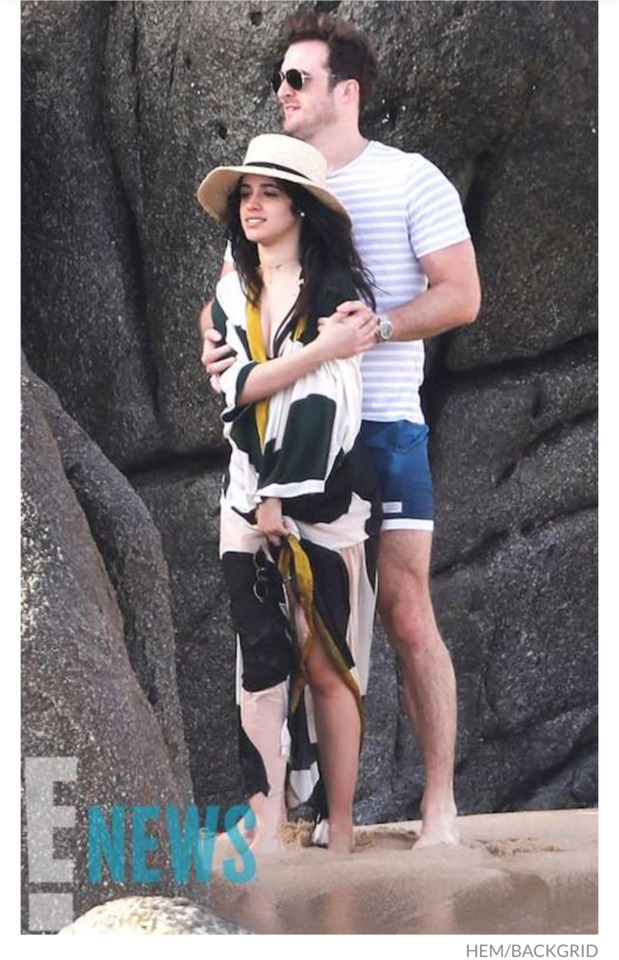
The photos were snapped with photo credits given to Backgrid, a known celebrity pap agency or "celebrity news agency" as they call themselves. Backgrid has also snapped pictures of a number of other celebrities in Cabo in 2018 as well including Scott Disick, Guiliana Rancic, Gwyneth Paltrow, Ciara, and Heidi Klum which were all published in gossip magazines/sites (i.e. US Weekly, OK, & E!News).
Feb. 15th, 2018: London, UK. Article 3.
Photo credits: Backgrid (JustJared).
CC leaving her hotel in London after announcing her first solo tour.
Feb. 20th, 2018: London, UK (London Fashion Week). Article 4.
Photo credits: Getty Images (Vogue).
Feb. 26th, 2018: LAX 1 (airport)*. Article 5.1, Article 5.2 (video).
Photo credits: Perez/X17online (DailyMail).
In the second pap pic of the pair as they walked through LAX, again a location known to have paps more so then any other airport in the states.

In fact, in order to allow celebrities and business professionals to evade paps, avoid public terminals, and make better use of their time LAX has invested hundreds of millions of dollars in a private terminal as well as VIP services to ensure privacy and efficiency (Source 1: LAX Private Terminal, Source 2: United Airlines partners with LAX private terminal, Source 3: Delta provides anti-pap VIP service, Source 4: American Airlines partners with private helicopter service Flyblade).
Mar. 14th, 2018: LAX 2 (airport). Article 6.1, Article 6.2 (video).
Photo credits: Backgrid USA (JustJared); X17online.
CC posing in LAX for paps Part I.
Note: Sinu can also be seen with CC in the video although she isn't shown in the article.
Apr. 8th, 2018: LAX 3 (airport). Article 7.1, Article 7.2, Article 7.3 (video).
Photo credits: Backgrid USA (JustJaredJr), starzfly/Bauer-Griffin/GC Images (Billboard); X17online.
CC (and Sinu) posing in LAX for paps Part II. There are 2 sets of photos posted from this day however, the second set (non-Backgrid) were the more popular ones which made the rounds on various news and gossip sites.
Apr. 17th, 2018: West Hollywood, CA. Article 8.
Photo credits: The Image Direct (DailyMail).
CC and Sinuhe out to lunch in West Hollywood.
Apr. 18th, 2018: LAX 4 (airport). Article 9.
Photo credits: Backgrid (Vogue).
May 23rd, 2018: Beverly Hills, CA. Article 10.
Photo credits: Backgrid (TMZ)
CC and Sinu spotted post-hospitalization following the Billboard Music Awards.

June 8th, 2018: Manchester, UK. Article 11.1, Article 11.2.
Photo credits: Eammon and James Clarke (Manchester Evening News), INSTAR (JustJaredJr).
CC shopping in Manchester city centre with her mother Sinu.
June 19th, 2018: Paris, France (NRJ radio station). Article 12.
Photo credits: Backgrid (JustJared).
CC heading into NRJ radio station.
June 25th, 2018: Barcelona, Spain (airport)*. Article 13.1, Article 13.2.
Photo credits: Backgrid USA/Backgrid (JustJared, Metro).
The third pap pic of the pair overall, second set of the pair snapped by Backgrid.
Note: CC's family were also present. They were all seen walking together, taking selfies, and kissing in CC and MH's case. CC and Sofi also posed for paps.
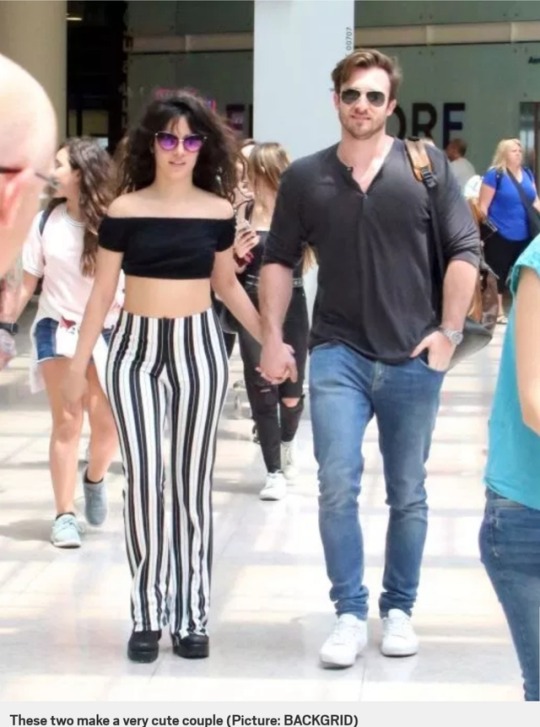
June 26th, 2018: Barcelona, Spain (park)*. Article 14.
Photo credits: Backgrid (E!News).
The fourth time papped as a pair, third set of photos taken by Backgrid as a pair abroad.
Note: This features the photos of CC on MH's lap on a park bench sitting next to Sinu and kissing. CC also goes down a slide with MH waiting at the bottom. Very reminiscent of 2016 Hiddleswift (HS 1.1, HS 1.2) or March 2018 Nick Jonas.
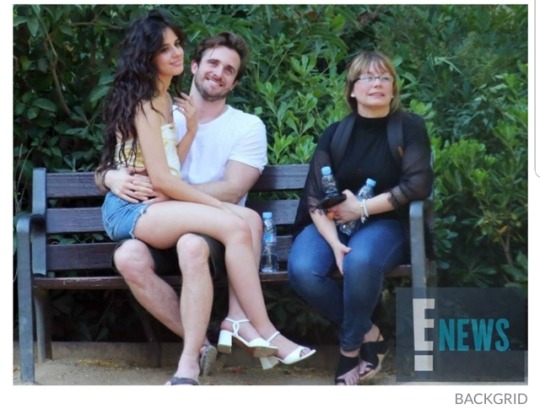
July 25th, 2018: LA/Pacific Palisades, CA (L'Oreal event)*. Article 15.
Photo credits: Backgrid (DailyMail).
CC and MH leaving the L'Oreal X Camila launch party for the "Havana" makeup collection.
(This photo is the 1/2 featured with MH which is work related.)
Note: Sinu and Sofi are also partially snapped in photos from the article.
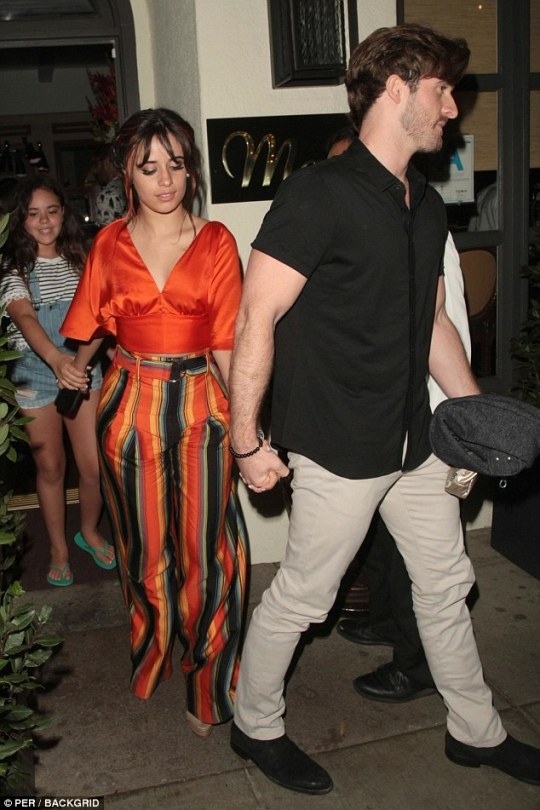
October 2nd, 2018: Venice Beach, California. Article 16.1, Article 16.2.
Photo credits: Backgrid (JustJared), (DailyMail)*.
Photos were taken of CC, MH, and Sinu strolling through Venice Beach.

October 15th, 2018: Sao Paulo, Brazil. Article 17.
Photo credits: Backgrid USA (JustJared), (DailyMail).
CC leaving a restaurant in Sao Paulo.
November 26th, 2018: Los Angeles, CA. Article 18.
Photos Credits: Backgrid USA (JustJared Jr.).
CC was snapped on the set of a music video.
December 6th, 2018: New York City, NY (Mastercard commercial)*. Article 19.1, Article 19.2, Article 19.3.
Photo Credits: Robert O'Neil/SplashNewsOnline; Backgrid USA, SplashNewsOnline (Just Jared, Just JaredJr.).
Photos of CC were taken during a shoot for a Mastercard commercial CC was filming. Prior to the shoot CC and MH were snapped strolling to a breakfast date in the DailyMail article although no photos of the date were presented in the article. Both Just Jared/Just Jared Jr. articles omitted details or photos of CC and MH together although the photos within the articles did mention the commerical she was filming and show moments from the shoot.
(This photo is the 1/2 featured with MH which is work related.)

January 31st, 2019: Hollywood, California (ArcLight movie theater)*. Article 20.1, Article 20.2, Article 20.3, Article 20.4.
Photo Credits: Roger/BACKGRID (DailyMail); Backgrid USA, SplashNewsOnline (JustJared, JustJaredJr.); Bauer-Griffin/SplashNews.com (E!News).
CC and MH snapped leaving a movie theater.
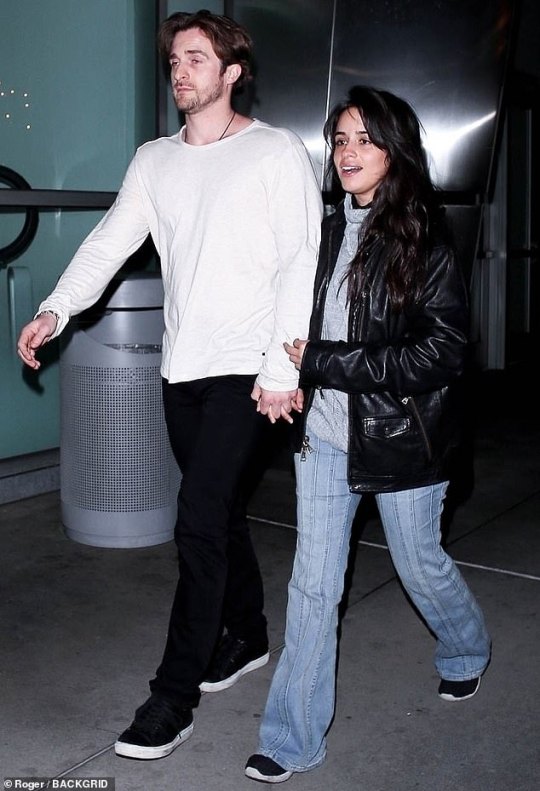
February 12th, 2019: LAX 5 (airport)*. Article 21.1, Article 21.2, Article 21.3, Article 21.4, Article 21.5 (video).
Photo Credits: Backgrid USA/BackGrid (JustJared, JustJaredJr; DailyMail; HollywoodLife); X17online.
CC and MH snapped at LAX only 2 days after the 2019 Grammys.
Note: In the video Sinu can be seen coming out of the vehicle with CC and MH at the airport, but immediately circles to the far left away from CC, MH, and their security guard opting to walk behind 2 paps and out of frame of the pictures instead.

The Rundown:
Total photo credits (21): Backgrid (16), X17online (4; first airport photos of CC and MH, 4 airport videos, all at LAX), SplashNews/SplashNewsOnline (3), Bauer-Griffin (2), Getty Images, starflyz, GC Images, The Image Direct, Eammon and James Clarke, and INSTAR.
Backgrid was credited for 16/21 of the days CC was papped from 2018 - February 2019.
The 5 days Backgrid was not given credit for any photos occurred between February 1st, 2018 - June 8th, 2018, from then through February 2019 Backgrid has had photo credits on every day CC has been papped.
7/21 of the days CC was photographed were in airports, of those 5/7 occurred at LAX. (Note: Despite frequent travels to NYC and Miami CC has not been papped once in 2018 flying into or out of JFK, LaGuardia, or MIA. In fact, the last time she appears to have been papped at any of these airports was LaGuardia in December 2014 with Dinah.)
Backgrid was the only ones who got pictures of CC 11/21 of the days and of those 5/11 included MH.
Backgrid was also given credit for 8/9 of the couple photos.
Also worth mentioning: 10/21 days CC was seen with a family member. 5/10 of those days also included MH, 4 were from June 25th, 2018 - October 2nd, 2018 and were the only 4 days CC was papped during that time period.
The news sites which consistently publish photos are the Daily Mail and Just Jared/Just Jared Jr with special recognition to E!News, rarely do other sites publish any photos.
Bonus link: Taylor Swift has also given exclusives to certain pap agencies for her PR relationships/bearding stunts. Namely The Image Direct for Hiddleston and Backgrid currently with Alwyn. Worth noting that CC and Taylor are friends and former tour mates.
273 notes
·
View notes
Text
in a wild twist, instead of just to-do listing i am retroactively to-do listing because for some reason i feel a desire to lay out everything i’ve done in the past few weeks as well as what i still have to do. i assume this is a processing thing. go about your business as usual
between 8/8 and 9/4:
go to maine
allow myself to be celebrated by extended family
change travel plans to drive to boston with parents
work out plans with boston friends
return to NYC
email new student buddy
buy plane tickets to CA
buy train tickets to DC
buy some decent new clothes for the first time in like 9 years so that i might hope for a shred of credibility as a teacher
buy something to wear to wedding #1
phone call with advisor about exam
follow-up call with advisor about exam
finish spreadsheet of every single thing published in [journal name redacted] between january 2009 and august 2019
tally frequency of topics in said spreadsheet over that period
choose two “major debates” from the spreadsheet
turn those debates + tally observations into a 3000 word essay
go to new student buddy lunch
finish political geography syllabus
(this included reading or rereading a LOT of stuff)
write annotated bibliography of everything on geography syllabus (idk how many things this was but the bib is like 16 single spaced pages? eta: i did a rough ~calculation and i think there are 60 or 70 texts on this list, all of which i had to summarize, explain relevance for, and position in relation to the other things i grouped with them on the syllabus)
do final edits on memory lit review
have followup mtg with the TLC people
figure out what the fuck is going on with the class i’m TAing
when does it meet again? where?
how do i get to QC?
lead first section
have meeting with professor
start the process of getting admin shit sorted out at QC
get blackboard access
find the fucking building where IT even is
get IT/email account set up
activate said account
inquire with judy about what to do about canceled class
spend like an hour figuring out how to add WIUs because our university’s website is a hellbegotten warren
register for GIS class
get judy to process overrides for this
file for state residency
download and print every single electric bill since i moved in here
download and print 2018 tax return
fill out form
clarify with HR that my current registration situation is not going to cost me money or cause other problems
travel to DC
attend wedding
make it back to NYC
find and download all the books for soc class
create decent file trees for this semester’s classwork and teaching
do reading for soc class week 1
prep overnight for leading section mtg #2
read 5 chapters
summarize 3
make a sheet for small group work
print 14 copies
lead section mtg
do reading for GIS class week 1
write response/questions for GIS class week 1
get access to GIS class’s TWO blackboard sites AND its wiki
sign up for presentation and note-taking responsibilities in GIS class
find out what the rules are for reference materials during the oral exam
do some extra side reading in prep for said oral exam
answer something like 10 student emails about absences and homework
msg TF about little syria
to do, 9/5-9/6:
PAY RENT
update blackboard site for my section because the prof keeps fucking changing shit
go to thursday lecture if i wake up and feel up to it bc frankly while i should go there is just. there’s a lot going on
on the other hand i should really do this so i can go back to the dreaded IT building at QC to get a campus ID so that i can let my own students into my classroom next week, god
do final prep for oral exam
reread submitted documents
print submitted documents
print metadata tab of spreadsheet in case
reread selections from syllabus and read others all the way through for the first time
maybe make some notes about this??
maybe make some notes about the things i know for sure i’ll be asked about
have oral exam
get fucking hammered with RJ
to do, 9/7-9/11:
start the equally insane ID acquisition process at HC again bc they only give you IDs that last for one year so you have to redo it every time
go to the office to get letter
inevitably email whatsername when she’s not there to set an appointment
therefore inevitably make second trip to office
take letter to ID office
get a new library sticker on GC ID
go to little syria tour with or without OA, who is not answering my texts
check in with him again to make sure he’s doing ok
go to It with MD
dry cleaning, maybe also laundry
decide whether to put my name in for a committee this year (why couldn’t this happen like ONE week later PLEASE)
reading for soc class
go to monday lecture
fucking prep for discussion section #3 further in advance this time
eat a damn vegetable (i ought to go grocery shopping but i’m going out of town again on the 14th so like what is the point)
identify, buy, and ship belated wedding gift for wedding #1
figure out gift for wedding #2
lead section mtg #3
figure out what the fuck is up with AAG
clean this absolute raccoon nest of an apartment oh my god??
3 notes
·
View notes
Text
How to Optimised Oncological Treatments: Lessons Learned from the First covid-19 wave by López E
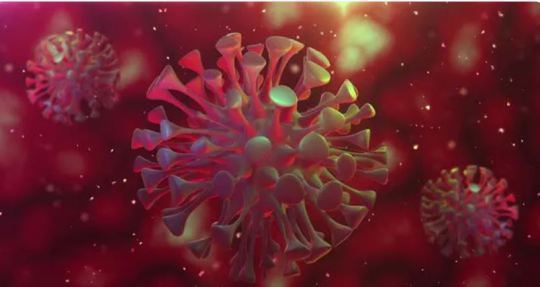
Abstract
Despite the local idiosyncrasies and different viral disease epidemiology resulting in country-specific governmental measures, our 70 centers located in Australia (32), United Kingdom (15) and Spain (21) joined forces and shared knowledge and experiences, which supported an appropriate clinical strategy for each country. The supply of Radio Therapy (RT) and/or Chemo Therapy (CT), and the safeguard of patients and staff in regard to their infectious status have been our priorities. In order to classify the changes in practice made during this pandemic we divide them into four major pillars that have impacted our culture and processes: oncology treatment, infection control, Information Technology (IT) infrastructure and staff connectedness. Facing a health crisis, the doctor leadership should be consolidated and for this reason, a high engagement of our doctors across the network is an essential key point. The oncology sanitary system should be continuously reinforced and should also be flexible plus solid.
Keywords: COVID-19; Chemotherapy; Leadership; Oncology; Radiotherapy; Staff
Introduction
In the first literature report of COVID-19 infection in oncologic patients the authors suggested three major strategies that would represent the backbone in delivery of oncologic treatments [1]. First, postponing adjuvant treatment or elective surgery. Second, personal protection for patient with cancer, cancer survivors and staff. Third, intensive surveillance or treatment in COVID positive patients with cancer.
During this pandemic, Spain was the first of the countries belonging to the Genesis Care (GC) international network affected by this outbreak. The first case in Spain for SARS-CoV-2 was diagnosed on 31 January 2020. By 13 March, cases had been confirmed in all 50 provinces of the country. From 17 March to 14 April, the death rate in Spain was 68% higher than usual and 21,882 excess deaths were recorded. The peak of excess deaths occurred during the week of 27 March to 3 April and was five times larger than the flu season of 2019.
Thus, Spain faced the main challenge to integrate strategies to minimize the deleterious effect of delayed diagnosis and treatment in cancer patients considering new ways of treating them, avoiding to postpone the start of treatments.
Despite the local idiosyncrasies and different viral disease epidemiology resulting in country-specific governmental measures, the three national chief medical officers of our 70 centers located in Australia (32), United Kingdom (15) and Spain (21) joined forces and shared knowledge and experiences, which supported an appropriate clinical strategy for each country. The supply of radiotherapy (RT) and/or chemotherapy (CT), and the safeguard of patients and staff in regard to their infectious status have been our priorities [2,3].
In order to classify the changes in practice made during this pandemic we divide them into four major pillars that have impacted our culture and processes: oncology treatment, infection control, Information Technology (IT) infrastructure and staff connectedness. The great enablers that have facilitated to treat our patients during the COVID-19 pandemics through the four pillars are shown in Table 1.
Our first pillar is oncology treatment looking for efficacy measures, we implemented two strategies: 1) To apply a tumor categorization protocol (Table 2) to determine the priority for RT delivery. Based on different factors such as tumor type and staging, intention-to-treat,
RT= Radiotherapy. SVCS= Superior Vena Cava Syndrome. SCLC= Small Cell Lung Cancer. SBRT= Stereotactic Body Radiotherapy. SPOT= non-melanoma skin cancer.9
General patient performance status and potential radiotherapy schedule approach, we classified the patients into 5 categories: rapid access/emergency radiotherapy (<14 hours or in the same day), A (<5days), B (>5 and <10 days), C (<4-6 weeks) and D (>6 weeks). This has allowed us, in an unprecedented situation, to balance the risk and benefit between treatments versus prevention of virus infection. 2) To increase the rate of hypo fractionated radiotherapy, achieving the same effectiveness with fewer sessions, in order to increase capacity in radiotherapy departments and reduce patient footfall in our centers. For instance, following the results of the Fast Forward trial, breast RT extreme hypo fractionation (26Gy/5#) is now an option for eligible patients (in two weeks we treated more than 90 patients). Similarly, in prostate cancer, moderate and ultra-hypo fractionation protocols such as 20# daily, 5# SABR and weekly 6# (total 36Gy) have been accepted as evidence-based protocols. Finally, for lung cancer patients who are also vulnerable to respiratory illness, a SABR regimen can be considered to standard fractionation. Staff and doctors have worked together to enable the implementation of the above protocols.
Regarding infection control, symptoms screening in patients and personnel before entering an oncology center presented an opportunity to identify possible cases with COVID-19 [4]. Discipline around general precautions by all staff including doctors and reinforcing the cleaning was used in order to keep a clean circuit. Besides, security lines, fixed screens for administrative staff and social distancing in waiting areas by re-arranging sitting areas to keep the 2m rule were performed and may remain as a global social change. The appropriate combination of personal protection equipment (PPE), selected through a risk assessment, was also used for infection prevention. Other useful measures were: Checking lung cone beam computed tomography of all patients with lung, breast or gastrointestinal superior cancers. This allowed not only to check the PTV we were treating but also to detect any abnormality which might be consistent with COVID-19. All these measures are included in our COVID-19 risk management framework [5] which should continue besides testing patients and staff when they screen positive for symptoms, with isolation measures in case of positive testing. An incidence was raised for any patient delay due to COVID-19 through a Multidisciplinary Team (MDT). COVID-MDT met with patient’s doctor, CMO and center manager to decide on patient treatment in case of positive swab for covid-19 [3]. A decision to treat end of day or delay treatment based on risks and benefits was made at the MDT. From our experience, we encourage the case-by-case assessment by a specialized board in future cases. Furthermore, routine asymptomatic staff and patient testing program should rule out to keep centers COVID-19 clean. In the first rapid testing around a 10.47% of our staff in Spain has been in contact with the disease and has generated IgG immunity.
Our third pillar is the IT infrastructure supporting a global network where some activities continued to ensure efficiency. A high percentage of staff members have worked from home through remote access to their platforms, having access to patient history and treatment planners (tele health). Oncologic follow ups were done by phone to reduce the people flow in the centers. Long survival follow-up (> 5 years) were also continued by phone with rapid access if it was needed. Also, psycho-oncologic attention was delivered by phone/digital media. The educational programs were done as Webinars and virtual congresses (teleconferencing). Electronic multidisciplinary teams (eMDT) were established at a time when clinician collaboration for patient care was more needed than ever [6]. It is run through a remote and safe platform, where clinicians can join in a synchronous or asynchronous way, record decisions and share report with the doctor, referrer, GP and patient if they so wish. To increase the communication through the whole network has been one of our priorities.
On the other hand, research continued for life saving trials and trials in set up. Two studies have been developed: Low doses of lung radiation therapy in cases of COVID-19 pneumonia: prospective, multicentric study in Radiation Oncology Centers (ClinicalTrials.gov Identifier: NCT04394182) and Genesis Care UK SARS-CoV-2 Antibody testing Program (both ongoing).
Our fourth pillar is staff connectedness. Regional managers and function managers worked very close to help physician unit coordinators with daily COVID-19 virtual huddles to discuss operational and quality issues and make decisions about center backup e.g.: minimizing the number of staff on site treating patients, having a schedule of backup in case staff fall ill, fewer face to face meetings and more virtual meetings, with staff spending more time home with their families and having time for home schooling Awareness across the network (local, national and international) has increased and this has fed into wellbeing. These plus the exercise and wellbeing program together with a strong medical leadership as part of the Integrative Cancer Care (ICC) holistic vision has led to the emergence of a solid team concept (“All for one and one for all”) that has generated a very strong engagement.
Our Oncology Departments have done a huge job, in a very short time. But now, with deescalated measures in Spain and other countries, we are presented with a unique opportunity to be a part of a cultural transformation in Oncology: The challenge of renaissance in the era post-COVID-19.
Some of the changes in practice which occurred in the COVID era are here to stay for several reasons. They improve patient and staff safety, lead to operational efficiencies, and efficacy in treatment, improve quality and team workflow and engagement. In addition, by continuing such strategies, we can be ready in case of another wave of this or a similar pandemic. This is an example of flexibility in our company, not only we have adapted to the difficult situation but also, we have learnt (innovation and improvement). Facing a health crisis, the doctor leadership should be consolidated and for this reason, a high engagement of our doctors across the network is an essential key point. The oncology sanitary system should be continuously reinforced and should be flexible plus solid as an accordion.
For more information about Article : https://ijclinmedcasereports.com/
https://ijclinmedcasereports.com/ijcmcr-rw-id-00162/
https://ijclinmedcasereports.com/pdf/IJCMCR-RW-00162.pdf
0 notes
Text
Juniper Publishers-Open Access Journal of Head Neck & Spine Surgery

The Role of Dexamethasone in the Era of “Dex-CSDH” Randomized Controlled Trial. A Multicenter, Prospective Study on Specific Subset of Patients with Chronic Subdural Hematoma (CSDH) Treated with Dexamethasone Alone or Surgery
Authored by Abhishek Chaturbedi
Abstract
Background: The efficacy of Dexamethasone as a method of conservative management for CSDH to avoid surgery remains inconclusive even after “Dex-CSDH” randomized controlled trial as almost all patients underwent an initial operation to remove the hematoma. Current study aims to determine the efficacy and safety of Dexamethasone alone therapy in comparison with the surgical drain of CSDH.
Methods: A multicenter, prospective study on mild to moderately symptomatic adult patients with CSDH were performed from January 2019 to December 2020. The patients were enrolled in a 1:1 ratio to receive a 3-weeks tapering course of oral Dexamethasone, starting at 4 mg thrice daily, or surgical drain of CSDH. The patient was assigned to a particular therapy based on their preference. The primary outcome was functional outcome in each group at 6 months determined by mRS, and cure rate (symptomatic relief and radiological resolution of CSDH).
Results: Twenty eights patients were assigned to Dexamethasone group and 30 patients to surgical group. The mean age of the patient was about 62 years in both groups with male predominance (>60%). A favorable outcome determined by mRS scale of 1 to 3 at 6 months follow-up was 25/28 (89.2%) in Dexamethasone group compared to 28/30 (93.3%) in surgical group (difference, -4.1 [95% CI, -6.8 to -2.2], p=0.12). The cure rate was 23/28 (82.1%) in Dexamethasone group compared to 28/30 (93.3%) in the surgical group during index admission (difference, -11.2, [95% CI, -14.3 to -7.6] in favor of the surgical group, p=0.005). Recurrence rate for CSDH was 2/28 (7.1%) in Dexamethasone group compared to surgical group 4/30 (13.3%) which was statistically significant (p=0.01). Morbidity related to medical therapy was not statistically higher compared to surgical group.
Conclusion: Current study exhibits superiority of surgery over Dexamethasone therapy for resolution of symptomatic CSDH. The recurrence rate of CSDH is lower in patients with corticotherapy compared to surgical drain. Patients in Dexamethasone group did not have functional outcome at 6 months or morbidity significantly higher than surgical group. This study strongly puts forward the utility of Dexamethasone as an effective and safe alternative to surgery for CSDH.
Keywords: Chronic subdural hematoma; Dexamethasone; Surgery; Functional outcome; Corticotherapy
Abbreviations: CSDH: Chronic Subdural Hematoma; CT: Computed Tomography; GCS: Glasgow Coma Scale; MRS: Modified Rankin Score; FFP: Fresh Frozen Plasm
Introduction
Chronic subdural hematoma (CSDH) is a common neurological disease prevalent in elderly population and has shown an increase in incidence due to extended life expectancy and use of blood thinners [1]. Burr-hole evacuation of CSDH is simple and easy to perform procedure with low morbidity rate (ranging from 0 to 9%) [2], but a rather variable rate of recurrence (10 to 20%) [3,4]. Surgery remains the mainstay therapy for patients with symptomatic CSDH with acceptable morbidity in medical community which produces excellent outcome and good symptomatic relief. Despite the excellent outcomes obtained by surgery, complications may occur, some of which may be potentially severe or fatal. Furthermore, up to 25% recurrence rate is reported.
Glucocorticoid has been used to treat CSDH [5], with acceptable efficacy and safety profile as stand-alone therapy to avoid surgery or as an adjunct to surgery to prevent recurrence of subdural fluid collection [6,7]. The Dexamethasone for Adult Patients with Symptomatic Chronic Subdural hematoma (Dex-CSDH) trial was a multicenter, randomized control trial conducted in the United Kingdom and published in December 2020 [8]. This recently concluded study aimed to determine the effect of Dexamethasone on outcomes in patients with symptomatic CSDH. It reported that most of patients (>90%) had to undergo surgical drainage of CSDH while on 2 weeks tapering dosage of Dexamethasone drug, which resulted in fewer favorable outcome and more adverse events compared to placebo at 6 months, but fewer recurrence of subdural fluid collection in the Dexamethasone group.
This provided much needed Class I evidence on Dexamethasone therapy to evaluate its effectiveness and its impact on the functional outcome of the affected patients. Since almost all the patients underwent surgery to evacuate CSDH while of Corticotherapy, the true effect of Dexamethasone as stand-alone therapy to treat this disease effectively, safely, with avoidance of surgery and prevent recurrence of subdural collection could not be ascertained by this study. Current study is a multicenter, nonrandomized but controlled, prospective clinical trial to determine the efficacy, safety and functional outcome of patients with standalone 3 weeks tapering dose of Dexamethasone medical therapy compared to surgical drainage of CSDH. Our study aims to add further clarity to the role of corticotherapy in conjunction with Dex-CSDH study in patients with chronic subdural hematoma.
Materials and Methods
Study design
This study is a multicenter, prospective clinical trial that was conducted in 4 different hospitals in Kathmandu, Nepal where the author treated the patients with CSDH. Patients were enrolled in stand-alone 3 weeks tapering course of Dexamethasone or burrhole evacuation of hematoma as the treatment modality based on patient’s preference. To be precise, the decision to perform surgical evacuation of subdural hematoma or conservative monitoring was made by the author following detailed discussion with the patient and patient’s next of kin. Hence it is a non-randomized study but a controlled study. The duration of the study was from January 2019 to December 2020 (2 years). We had almost 1:1 ratio between the two cohorts of patients. Dexamethasone group had total of 28 patients, while there were 30 patients in the surgical group who met eligibility criteria and fulfilled follow-up requisite.
Informed written consent was obtained for all patients who had surgery for CSDH. Verbal consent was obtained and noted in the medical records who preferred stand-alone Dexamethasone therapy as the treatment modality for CSDH. A chronic subdural hematoma was defined as a predominantly hypodense or combination of hypodense with isodense (relative the brain grey matter) crescentic collection along the cerebral convexity on computed tomography (CT) of the head.
Eligibility criteria
Inclusion Criteria: 1) The hematoma has be to be chronic or predominantly chronic with component of subacute blood 2) Glasgow Coma scale (GCS) on initiation of both alternative therapies of 13-15, 3) Modified Rankin Score (mRS) of 1-3 (see below for details on mRS scoring system) 3) Strict adherence to 3 weeks regimen of Dexamethasone as per the prescribed format [see below] 4) Follow-up on a weekly basis for patients on corticosteroid therapy to look for complications or adverse events associated with it 4) Follow-up CT scan every week for patients on corticosteroid therapy and before hospital discharge for index admission of patients with surgical evacuation of hematoma 5) Trauma or spontaneous CSDH were included in the study 6) Patients on anticoagulant or antiplatelet agent when CSDH was discovered 6) Patients who were available for evaluation of their clinical status, functional outcome and repeat CT head at 3 and 6 months follow-up visit after completion of their respective therapies.
Exclusion Criteria: 1) Subdural hygroma 2) Patients on antiplatelet or anticoagulants 3) Asymptomatic patients 4) Patients with poor neurological or functional status as is evident in inclusion criteria, GCS <13 and mRS>3 were excluded as per the pre-fixed study design [explained in discussion part] 4) Contraindications for glucocorticoid use (e.g. uncontrolled diabetes mellitus, recent peptic ulceration or gastrointestinal bleeding, severe valvular heart disease or unstable angina pectoris, active systemic infection, lactose intolerance, had a cerebrospinal fluid diversion shunt, known hypersensitivity to Dexamethasone, had a history of psychotic disorder and patients receiving glucocorticoid oral or intravenous within the last 1 month 5) Patients who failed Dexamethasone therapy and had subsequent surgical evacuation of CSDH were not included in the surgical arm of patients 7) any pre-existing medical condition that precludes surgical drainage of CSDH.
Patients
Patients with symptomatic CSDH who were eligible for the study were explained the pros and cons about both forms of treatment modalities. They were explicitly told that Dexamethasone as a stand-alone treatment may not lead to resolution or significant reduction of CSDH, which may ultimately lead to surgical drainage of blood to alleviate the neurological symptoms. This drug has inherited complications/side effects which needs to be carefully monitored during the prescribed period of treatment. The pros and cons of surgical drainage of subdural fluid collection through a burr-hole was also explained along with the complications related to surgical procedure.
Treatment protocol
All patients in this study were enrolled with intention to treat mindset using two different treatment protocol. All the patients under the surgical arm underwent standard single or double burr-hole evacuation of CSDH (based on surgeon’s discretion) with placement of subdural drain to a closed system for 1-2 days in the hospitals with neurosurgical units. The anticoagulant and antiplatelet effect were reversed with fresh frozen plasm (FFP) and platelet infusion if there is urgency to perform surgical drain of CSDH. Otherwise, about 10 days was awaited after discontinuation of blood thinners before performing surgery. Patients who had steroid therapy received a tapering 3-weeks course of oral Dexamethasone at home or assisted living facility (4mg thrice daily on days 1 to 3, then 3mg thrice daily on days 4 to 6, then 2mg thrice daily on days 7 to 9, then 2mg twice daily on days 10 to 12, then 1mg thrice daily on days 13 to 15, then 1mg twice daily on days 16-18, then 1mg once daily form 19-21 days and then stopping the therapy). A proton pump inhibitor was given during corticotherapy to prevent steroid induced peptic ulceration.
Patients who had dexamethasone therapy for resolution of CSDH were evaluated on outpatient basis weekly with fasting and post-prandial blood sugar and blood tests for the presence of newonset diabetes and hypokalemia respectively, steroid induced new-onset psychosis, peptic ulceration and gastrointestinal bleeding, and other gastrointestinal side effects. Adherence to medical therapy was confirmed by reviewing patient’s or next of kin medication records and patient diaries to confirm that the medication was taken at home. Patients who were symptomatic and CT head showed mass effect from persisting CSDH despite completion of 3 weeks of Dexamethasone therapy were given option to undergo surgery to evacuate the hematoma. If agreed upon, these select group of patients underwent standard burrhole evacuation of CSDH with subdural drain.
Outcomes
The author believes that Dexamethasone is a potent antineomembrane and anti-angiogenic agent which is safe and effective treatment for CSDH that positively compares to surgical drain of the subdural collection. The author does not intend to undermine the importance of surgical evacuation of CSDH, but Dexamethasone can be a viable option, especially in specific circumstances, especially in patients with CSDH with minimal or moderate symptomatology and not severely affected neurologically or functionally. In these select subset of patients with chronic subdural hematoma, corticotherpay can be a conservative alternative treatment option in comparison to surgical drain of subdural blood collection.
Ethical issues seems to be a non-entity in this study considering patient or his/her next of kin chose the treatment modality on their own accord which has proven to be effective backed by evidence based medicine and substantial literature on both modalities of treatment for CSDH [8,9]. The modified Ranking scale (mRS) is an ordinal scale to evaluate patient’s functional status with respect to activities of daily living and has wide spread clinical application for several diseases [10,11]. This scale has seven categories: no symptoms-0, no clinically significant disability despite symptoms-1, slight disability-2, moderate disability-3, moderately sever disability-4, severe disability-5, and death-6; in this study, a score of 0 to 3 was used to indicate a favorable outcome.
In lieu with the previous studies of CSDH [12,13], the primary outcome was 1) a score of 0 to 3 on the mRS at 6 months after enrollment in the study, suggesting favorable outcome 2) resolution or significant reduction of chronic subdural collection at the end of index admission for the surgical group and at the end of 3 weeks of dexamethasone therapy for medical group (designated Cure Rate in current study). Resolution of SDH was defined as above 90% reduction in the thickness of the fluid collection with symptomatic relief. Significant reduction was described as above 75% reduction in the thickness of the subdural collection of blood with symptomatic relief.
Secondary outcome was the score on mRS at the end of each respective therapies and at 3 months interval after completion of respective treatment modalities, the number of patients who had to undergo surgical interventions during subsequent admission in the follow-up period. This entails surgery for recurrence of subdural hematoma following burr-hole evacuation of subdural collection in the surgical group or after corticotherapy. Surgical intervention in patients who had corticotherapy and could not effect a cure is also reported in current study. Post-operative recurrence of CSDH was defined as symptomatic re-accumulation of the ipsilateral subdural fluid that was previously evacuated.
Tertiary outcome was mortality at 30 days and 6 months after enrollment of patients in two distinct therapeutic modalities. It also includes morbidity related to both medical and surgical therapies.
Statistical Analysis
The two cohort of patients (surgical group vs Dexamethasone group) were matched for age, sex, GCS on presentation and initial modified Rankin Score. Overall effect was shown with the risk ratio (RR) and its 95% confidence interval (95% CI). Comparisons between Dexamethasone alone therapy versus the surgical drain were made to identify the effectiveness of Dexamethasone therapy. A two-tailed P value < 0.05 set as the level of significance under the assumption of a normal distribution curve in the current study. Statistical significance between two groups was examined by Pearson Chi-Square test or Fisher exact test for categorical variables and Student t-test or Mann-Whitney U-test for continuous variables respectively. Multivariate Logistic Regression analysis models (using the ordinal modified Rankin Scale) [14] were performed to compare variables between two select cohorts.
Results
The age in each group was about 62 years, with male predominance (64% in Dexamethasone group and 67% in the surgical group) (Table 1). The most common cause of CSDH, irrespective to the assigned group for patients with CSDH was head trauma (about 67%), followed by use of blood thinners and spontaneous in nature (14.2% and 18% in Dexamethasone group, and 16.7% and 16.7% in the surgical group respectively). Head, gait instability and cognitive impairment were the most common presenting symptoms in descending order (71.4%, 53.6% and 43% in Dexamethasone group as compared to surgical group (70%, 56.6% and 46.6% respectively). Ischemic heart disease, diabetes mellitus and chronic obstructive pulmonary disease were the most common presenting morbidity in each group (43%, 28.5% and 21.4% in Dexamethasone group compared to 46.6%, 33.3% and 26.6% respectively). The midline shift in brain due to mass effect from ipsilateral CSDH is most commonly in the range of 6-10 mm as evident on CT head (43% and 46.6% in Dexamethasone group and surgical group respectively). The patients who underwent surgery during index admission for surgical drain of SDH mean stay with SD was 5 days ±1.8.
Primary outcome
A favorable functional outcome determined by modified Rankin scale (mRS) score of 1 to 3 at 6 months follow-up was 25/28 (89.2%) in Dexamethasone group compared to 28/30 (93.3%) in surgical group (difference, -4.1 [95% CI, -6.8 to -2.2], p value =0.12). The difference was not statistically significant. The cure rate was 23/28 (82.1%) in Dexamethasone group compared to 28/30 (93.3%) in the surgical group during index admission (difference, -11.2, [95% 95% CI -14.3 to -7.6] in favor of the surgical group, p=0.005). About 18% patients (5/28) had to undergo surgical drain of subdural collection for failure to resolve following full course of corticotherapy.
Secondary outcome
A favorable functional outcome (mRS score of 1-3) at 3 months follow-up was 26/28 (92.8%) in Dexamethasone group compared to 28/30 (93.3%) in surgical group (difference, -0.5 [95% CI, -2.2 to -0.1], p value =1.24 (Table 2). It was comparable between 2 groups at 3 months follow-up. Similarly, at the time of discharge for surgical group during index admission and end of therapy for oral dexamethasone group, favorable outcome determined by mRS was not statistically significant. It was 25/28 (89.2%) in Dexamethasone group compared to 28/30(93.3%) [Point Difference -4.1 (-8.8 to -2.2), p value= 0.08]. Hence at no point in time, surgical group had significantly better outcome compared to corticotherapy group. Only 3 patients (10%) in the surgical group had to undergo repeat evacuation of subdural fluid collection during index admission after first surgery failed to resolve CSDH. Three patients (10%) in the surgical group had subsequent surgery for tension pneumocephalus, contralateral acute subdural hematoma and acute intracerebral hemorrhage (the latter probably due to brain laceration from the subdural irrigation catheter). Recurrence rate for CSDH was 2/28 (7.1%) in Dexamethasone group compared to surgical group 4/30 (13.3%) [Point difference of –6.2 (-4.2 to -8.4)] which was statistically significant (p=0.01).
Tertiary outcome
Morbidity related to stand alone Dexamethasone therapy and surgical drainage of CSDH were 17.8% (5/28 patients) compared to 13.3% (4/30) with Rate Ratio of 1.34 (range 0.8 to 1.7) with p value of 0.10. Hence morbidity related to corticotherapy did not reach statistical significance compared to the surgical therapy. The most common adverse effects related to medical therapy (Table 3) was hyperglycemia 17.8% (5/28 patients), followed by gastrointestinal problems including peptic ulceration and nosocomial infection, latter two representing 2/28 patients each (7.1%). In the surgical group, the most common complications were superficial wound infections in 3 out 30 patients (10%) and inappropriate secretions of ADH leading to hyponatremia (2/30 patients, 6.6%). They were managed with appropriate antibiotics and water/fluid restriction. No morbidity related to either therapy were life threatening in this study. There was no mortality at the time of discharge after surgery or end of medical therapy, same applies at 3 months follow-up period. Mortality was 1 patient each in assigned groups at 6 months follow-up, which was not directly related to treatment instituted.
Discussion
Chronic subdural hematoma is a common but retractable neurological disease in the elderly with a noteworthy recurrence rate (up to 25% has been reported in the literature) [9]. The pathophysiology of CSDH has been well elucidated. The process of re-bleeding and breakdown of erythrocytes exacerbated the inflammatory reaction, following by the formation of neomembrane and neo-capillaries. This cycle of the re-bleedingcoagulation- fibrinolysis process eventually led the hematoma to enlarge or recur [9]. Glucocorticoid, a potent anti-inflammatory agent has been found to inhibit neo-membrane and neoangiogenesis [15]. This has been the rationale for the use of Dexamethasone orally or intravenously to treat CSDH.
A review and meta-analysis study on Dexamethasone role for CSDH concluded even though corticotherapy has been used as stand-alone medical therapy, it’s effectiveness as a better alternative to surgical therapy has not been proven [9]. But adjuvant Dexamethasone therapy to surgical drain of CSDH is known to reduce the recurrence of this disease. Trial of Dexamethasone for Chronic Subdural Hematoma (Dex-CSDH) provided much needed multicenter randomized controlled study to elucidate efficacy and safety of Dexamethasone compared to placebo in treating symptomatic CSDH [8]. In this study, almost all patients underwent an initial operation to remove hematoma, no firm conclusion could be drawn regarding the effect of Dexamethasone as a method of conservative management to avoid surgery. However, it did further strengthen the existing literature about the potency of corticotherapy to avoid recurrence of chronic subdural hematoma.
Current study is inspired by anecdotal experience of the author in successfully implementing corticotherapy as standalone therapy for symptomatic CSDH. In his experience, he got better results from 3 weeks of tapering regimen of oral Dexamethasone drug as compared to routinely used 2 weeks of corticotherapy in respect to resolution of subdural fluid collection. This was achieved with acceptable adverse effects related to considerable period of glucocorticoid therapy with strict vigilance of patient during this therapy. When pilot study on Dex-CSDH was published in 2019 with its inception in 2015 [16], the author was enthusiastically propelled to contemplate similar study in the country of his medical practice. The author wanted to conduct a randomized controlled trial comparing the efficacy and safety of Dexamethasone therapy with surgical drain of subdural collection.
Since patient were not keen on randomization and their preference of therapy was paramount, it ended up being a multicenter, prospective, non-randomized but controlled study. The author believed that CSDH patients with poor neurological and functional status should be subjected to surgical drainage for urgent alleviation of their symptomatology and neurological recovery. Hence, mild to moderately symptomatic patients with favorable functional outcome were only enrolled for corticotherapy (GCS of 13-15 and mRS score of 1-3). Being a comparative and controlled study, the surgical group also constituted patients with similar neurological and functional status as Dexamethasone group. All the eligible patients who were assigned to either Dexamethasone group or surgical group were matched for age, sex, GCS score and mRS score at the time of enrollment in the study.
Current study shows that at 6 months follow-up, functional outcome of patients based on modified Rankin Score scale was not statistically significant between stand-alone Dexamethasone group and surgery group. Similar picture emerged for patient’s functional outcome at end of respective therapies or at 3 months following discharge from medical care. However, the cure rate which specified significant or complete resolution of CSDH with symptomatic relief was statistically significantly higher in surgical arm compared to medical therapy (82.1% for Dexamethasone group vs 93.3% for surgery group, P value of 0.005). The recurrence rate for CSDH in Dexamethasone group was lower compared to surgical group which reached statistical significance (7.1% for corticotherapy vs 13.3% for surgical group, P value of 0.01). This is line with most of the studies in existing literature and corroborated by Dex-CSDH study [8].
As shown by various study including Dex-CSDH trial , in this study adverse effects or morbidity related to Dexamethasone therapy was not markedly higher compared to surgical therapy (not statistically significant on analysis). None of the patients in this study had life threatening complications related to respective therapies. About 18% (5 out of 28 patients) in medical treatment group had failure of therapy to resolve CSDH, hence underwent surgical evacuation of the subdural collection. This is in contrast to 2 patients (6.7%) who failed to be cured by surgical evacuation of subdural hematoma at the end of index admission. These two patients had multi-loculated subdural hematoma which prevented from surgical cure. In totality, 3 patients had re-do surgery for removal of residual and symptomatic CSDH during index admission through burr-hole drainage. Three patients (10%) in the surgical group had subsequent surgery unrelated to recurrence of CSDH (e.g., tension pneumocephalus, contralateral acute subdural hematoma collection etc.). There was one mortality among patients belonging to both types of therapies at 6 months follow-up, but probably unrelated to the instituted therapies.
Our trial has limitations, the most important being a nonrandomized trial and small sample size. Another arm of patients with Dexamethasone as an adjunctive treatment to surgery would have added more clarity and substance to this study.
Conclusion
Current study exhibits superiority of surgery over Dexamethasone therapy for resolution of symptomatic chronic subdural hematoma. The recurrence rate of CSDH is lower in patients with corticotherapy compared to surgical drain. Patients in Dexamethasone therapy did not have morbidity significantly higher than surgical group. This study strongly puts forward the utility of Dexamethasone as a viable alternative to surgery for CSDH. It can be a safe and effective stand-alone therapy especially in subset of CSDH patients with initial good neurological and functional status.
For more articles in Open access Journal of Head Neck & Spine Surgery | Please click on: https://juniperpublishers.com/jhnss/index.php
For more about Juniper Publishers | Please click on: https://juniperpublishers.com/pdf/Peer-Review-System.pdf
#Head and Neck Surgery Journal#Chronic subdural hematoma#dexamethasone#surgery#Functional outcome#Corticotherapy
0 notes
Text
Tour de France Guide
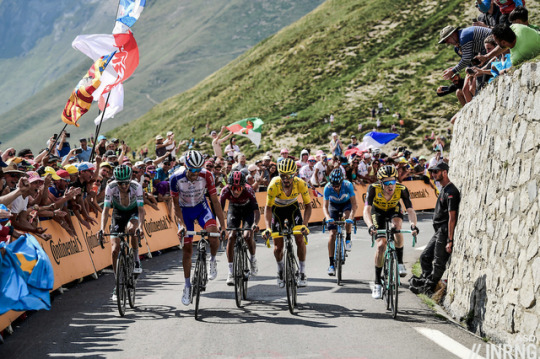
Here’s the 2020 Tour de France guide. There’s a profile of every stage with a quick take on the day. You’ll also find reference material on the race rules like time bonuses, the points scale for the green and polka-dot jersey, time cuts and plenty more. This is a blog post but you’ll find a permanent page on the menu at the top of the page or just remember or bookmark inrng.com/tour in case you need it for reference.

Route Summary
The map says plenty, the race sticks to France’s southern half which means more hills and mountains. This is an anti-siesta Tour course, there will still be some majestic slow moments but there are few sprint stages and the race is never far away from a tricky climb. There’s no gentle introduction, the opening weekend in Nice will be hectic, there’s a ski station summit finish on Stage 4 and there are many mid-mountain stages with Mont Aigoual, the Suc-au-May, the Puy Mary and the Grand Colombier before the final Alpine week and the final 36km time trial.
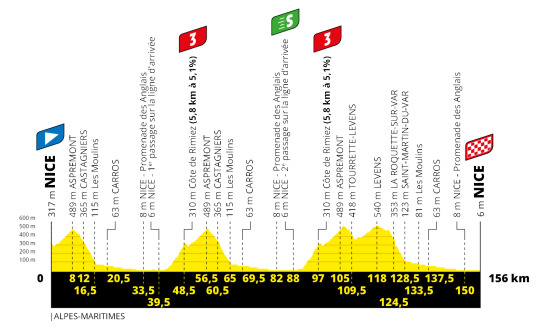
Stage 1 – Saturday 29 August
A circuit in Nice that’s reminiscent of the final stage of Paris-Nice which is often a highlight of the season. This time it’ll be different as an opener, more riders and teams with cards to play and way more hectic.
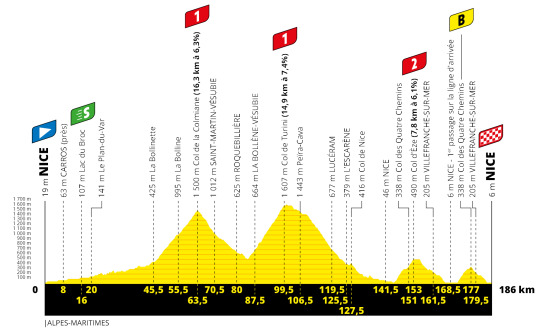
Stage 2 – Sunday 30 August
A solid day in the Alpes-Maritimes, with the big climbs of the Colmiane and the Turini mid-stage before a hilly circuit around Nice.

Stage 3 – Monday 31 August
One for the sprinters, they have few chances in this race so their teams have to make today count and they’ll aim to control the race here.
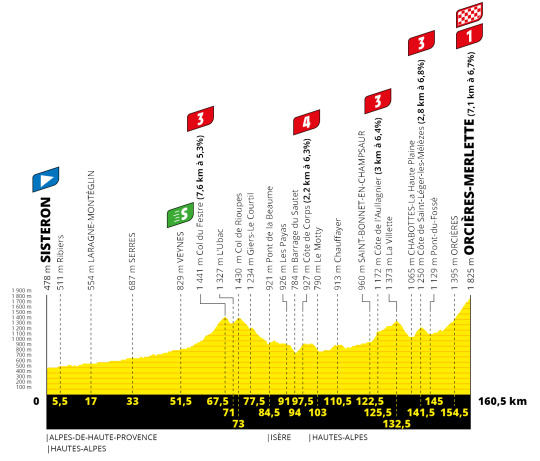
Stage 4 – Tuesday 1 September
The Tour returns to Orcières-Merlette, a ski resort with its place in Tour history thanks to the stage in 1971 where Luis Ocaña got the better of Eddy Merckx for once, and by eight minutes. But no time for nostalgie, it’s only Stage 4 and here’s a summit finish to see the GC contenders in action.

Stage 5 – Wednesday 2 September
Another chance for the sprinters, the late climbs are gentle and on a wide road and if the profile suggests an uphill finish into Privas it’s only the softest of rises.

Stage 6 – Thursday 3 September
Mont Aigoual but to get there the Col de la Lusette which is narrow, rough and steep, it should be selective before the more gentle passage across to the finish.
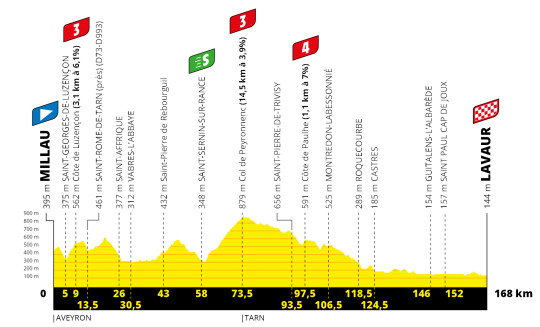
Stage 7 – Friday 4 September
Another chance for the sprinters but watch out for the vent d’Autan, the local wind which caused havoc in last year’s race on the roads to Albi.

Stage 8 – Saturday 5 September
The Pyrenees and three passes which get successively easier but still make for a hard day because of the intensity, it’s only 141km and things should be lively from the start.
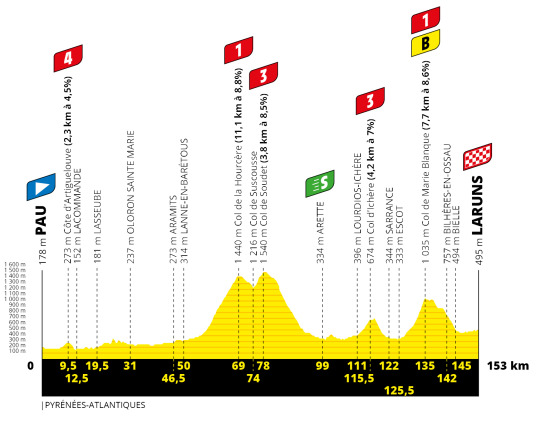
Stage 9 – Sunday 6 September
A busy day in the Pyrenees, the Marie Blanque might look small on the profile but the final 4km are 10-12% most of the way so if riders can get a gap here they’ve got a good chance of holding it to the finish.

Stage 10 – Tuesday 8 September
A scenic stage along the Atlantic coast between two islands famous as prized Parisian holiday destinations. An obvious day for the sprinters but watch out for the sea breeze.
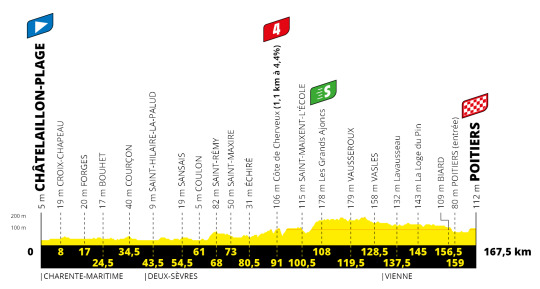
Stage 11 – Wednesday 9 September
The probable siesta stage, unless the weather intervenes there’s not much going on, even the scenery is a bit plain.
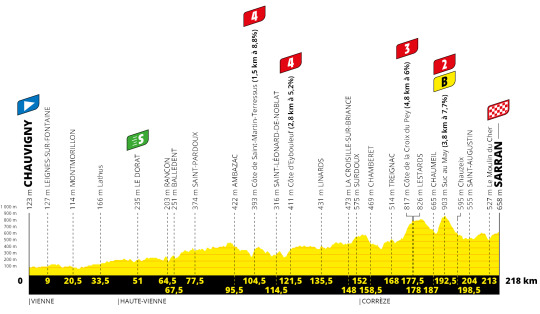
Stage 12 – Thursday 10 September
The longest stage of the race and it should allow time to evoke a golden age of cycling with Raymond Poulidor, Jean Ségurel and Antoine Blondin to fill the time. But for the riders it’s a hard stage, the route gets progressively hillier and the Suc-au-May is far harder than the profile suggests, all before an uphill finish in Sarran.

Stage 13 – Friday 11 September
Another long stage and a tough finish in the volcanoes of the Auvergne, climbing the Puy Mary via the Col de Neronne is hard going and the final 2km are at 13%.
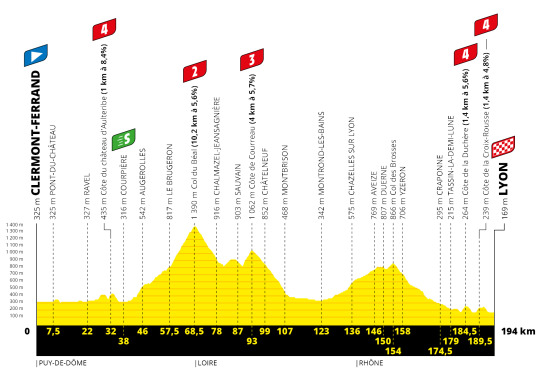
Stage 14 – Saturday 12 September
A good day for a breakaway, many will have today marked in their diary because it’s accessible to anyone who goes in the day’s move. Cycling is essentially a rural sport but here’s an urban finish in Lyon and there are some tricky climbs on the approach.

Stage 15 – Sunday 13 September
A really hard stage, what the climbs lack in altitude they make up for in attitude. The “Selle de Fromentel” is the steepest side road up the Grand Colombier with long sections at 14-16% before the steep Col de la Biche and its bone-rattling descent. There’s a short breather before climbing the Grand Colombier from Culoz, via the increasingly famous lacets or hairpins.

Stage 16 – Tuesday 15 September
A quick crossing of the Chartreuse Alps and then it’s across to the Vercors and a finish in Villard-de-lans, the same used in the 2015 Critérium du Dauphiné. It’s a great day for the breakaway.
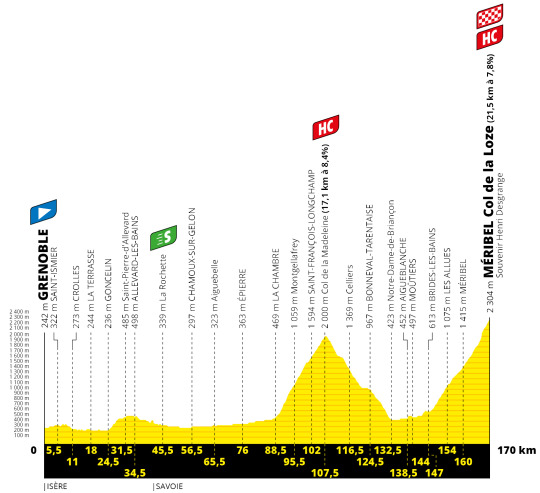
Stage 17 – Wednesday 16 September
A tough Alpine stage, there’s a dash up the Grésivaudan valley to start the giant Col de la Madeleine and then comes the Col de la Loze. After a difficult ascent to Méribel with plenty of selective 8% sections the race flicks onto the brand new Loze cycle path for a summit finish like nothing else, there are 20% ramps and other nasty surprises.

Stage 18 – Thursday 17 September
A very hard day’s racing with no let up, there’s barely a metre of flat all day. The Saisies and Aravis are regular cols before the climb to the Plateau de Glières. There are steeper climbs, there are longer climbs but few in France are as steep for as long and then it’s the scenic traverse of the plateau across the gravel road before a technical descent, then the big ring climb of the Col des Fleuries on the way to the finish.

Stage 19 – Friday 18 September
A tug of war between the breakaway riders and the sprinters’ teams, there’s a flat finish but the last 60km are on lumpy roads.
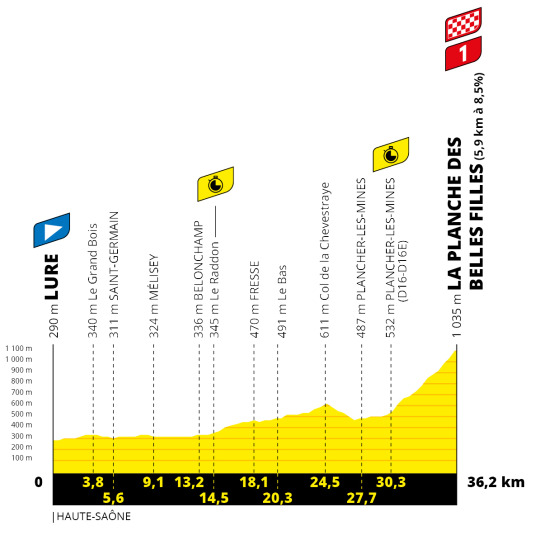
Stage 20 – Saturday 19 September
The only time trial of the race and in three parts: a flat section through Mélisey, home of Thibaut Pinot – and where his father Régis is both mayor and undertaker – then a drag up to the Col de la Chevestray and its descent. Finally there’s the awkward climb of the Planche des Belles Filles and this time “just” the normal finish, the riders are spared the gravel extension used in 2019.

Stage 21 – Sunday 20 September
Assuming the race has made it this far then it’s the usual 60km parade that mutates into a 60km criterium and the evening finish on the Champs Elysées.

The Jerseys
Yellow: the most famous one, the maillot jaune, it is awarded to the rider with the shortest overall time for all the stages added together, the rider who has covered the course faster than anyone else. First awarded in 1919, it is yellow because the race was organised by the newspaper L’Auto which was printed on yellow paper. Today it is sponsored by LCL, a bank. There are time bonuses of 10-6-4 seconds for the finish of each stage except the time trials. There are also 8-5-2 seconds at the bonus sprints marked “B” on the profiles above on Stages 2,6,8,9,12,13,16 and 18, typically atop various mountain passes.
Green: the points jersey, which tends to reward the sprinters. Points are awarded at the finish line and at one intermediate point in the stage and the rider with the most points wears the jersey. It is sponsored by Skoda, a car manufacturer
Flat stages (Stages 1,5,7,10,11,19,21) 50-30-20-18-16-14-12-10-8-7-6-5-4-3 and 2 points for the first 15 riders
Hilly finish / Medium mountain stages (Stages 2,3,6,12,14,16): 30-25-22-19-17-15-13-11-9-7-6- 5-4-3-2 points
Mountain Stages + individual TT (Stages 8,9,13,15,17,18) : 20-17-15-13-11- 10-9-8-7-6-5-4-3-2-1 points
Intermediate sprints: 20-17-15-13-11-10-9-8-7-6-5-4-3-2-1 points
Polka dot: also known as the “King of the Mountains” jersey, points are awarded at the top of categorised climbs and mountain passes, with these graded from the easier 4th category to the hors catégorie climbs which are so hard they are off the scale. In reality these gradings are subjective. Again the rider with the most points wears the jersey. It is sponsored by Leclerc, a supermarket.
Col de la Loze: 40-30-24-20-16-12-8-4 points for first eight riders
Hors Catégorie (4 in total): 20-15-12-10-8-6-4-2 points
Category 1 climbs (15): 10-8-6-4-2-1 points
Category 2 (9): 5-3-2-1 points
Category 3 (21): 2-1 points
Category 4 (15): 1 point
White: for the best young rider, this is awarded on the same basis as the yellow jersey, except the rider must be born after 1 January 1995, ie aged 25 or under. It is sponsored by Krys, a retail chain of opticians
Obviously a rider can’t wear two jerseys at once, they’d get too hot. So if a rider leads several classifications, they take the most prestigious jersey for themselves and the number two ranked rider in the other competition gets to wear the other jersey. For example if a rider has both the yellow jersey and the mountains jersey they’ll wear yellow while whoever is second in the mountains jersey will sport the polka dot jersey. If a rider has all the jerseys the priority yellow, green, polka dot then white.
There’s also a daily “most combative” prize awarded every day to the rider who has attacked the most or tried the hardest. It is a subjective prize and awarded by a jury. The rider gets to stand on the podium after the stage and wear a red race number the next day. There will be a final Supercombatif prize with involvement from the jury and social media. It is sponsored by Antargaz, a bottled gas company.
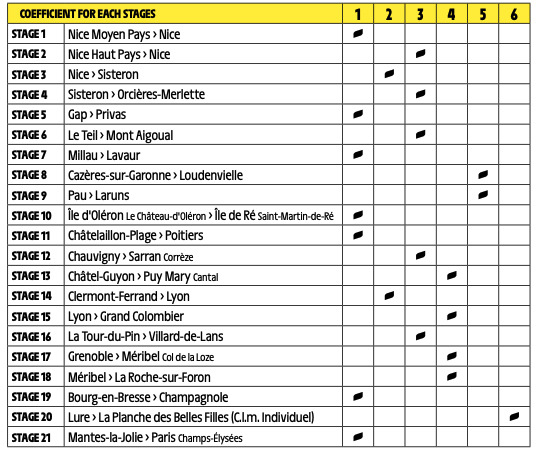
Time Cuts
The time cut depends on the stage in question. Look up the stage and its coefficient on the table above and then match it to the listings below. It’s the same tight schedule for the mountains as the last two years, sprinters beware.
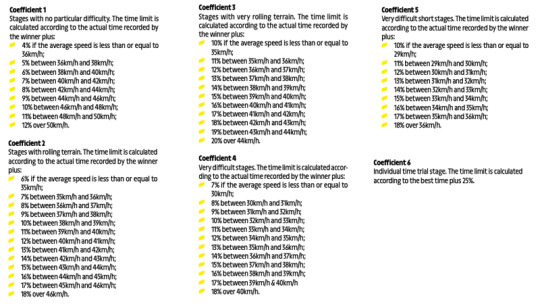
Timekeeping
Normally a one second gap on the finish line is needed to separate groups in a finish but for Stages 1,3,5,7,10,11,14,19 and 21, the likely sprint stages, three seconds is needed for a split in the field. The three kilometre rule doesn’t apply on Stages 4,6,13,15,16,17 and 20.
The unmissable stages
This is the Tour de France and there’s always something to watch but there are some stages that matter more than others. If you need to plan ahead, here are some suggestions for the stages to watch.
Stage 1: the hectic opener around Nice
Stage 2: a big day in the hills behind Nice
Stage 4: the first summit finish
Stage 6: Mont Aigoual via the tough Col de la Lusette
Stage 8: the first day in the Pyrenees
Stage 9: more Pyrenees with the tricky Col de Marie Blanque
Stage 15: the Grand Colombier summit finish
Stage 17: the manic Col de la Loze
Stages 18: the final day in the Alps
Stage 20: the Planche des Belles Filles time trial
TV Guide
Every stage will be shown live from start to finish. Think of it like the radio, something to have in the background or in a more modern way you can tune in from time to time via your phone in case there’s early action. The daily finish time varies between 5.00pm-5.55pm CEST each day.
The race will be broadcast on a variety of channels around the world. There is no free stream on the internet but you will find a feast of legitimate feeds from local broadcasters and international sources like Eurosport.
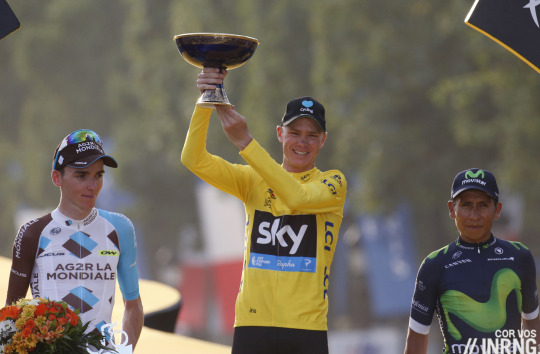
The Prizes
Each day on a normal stage there’s €11,000 for the winner, €5,500 for second place and a decreasing scale down to a modest €300 for 20th place
For the final overall classification in Paris, first place brings in €500,000 and the Sèvres porcelain “omnisports trophy”, awarded “in the name of the Presidency of the French Republic”. The full breakdown is €500,000 for first place, €200,000 for second place, €100,000 for third place and then €70,000, €50,000, €23,000, €11,500, €7,600, €4,500, €3,800, €3,000, €2,700, €2,500, €2,100, €2,000 €1,500, €1,300, €1,200 and €1,100 for 19th place. €1000 for 20th-160th overall
There are other pots of money available in the race:
€500 a day to whoever wears the yellow jersey, €300 for the other jersey holders
€25,000 for the final winner of the green and polka dot jerseys
€20,000 for the final winner of the white jersey
There’s also money for the first three in the intermediate sprint each day: €1,500, €1000 and €500
The climbs have cash too with the first three over an HC climb earning €800, €450 and €300 and lesser sums for lesser climbs
The highest point in the race sees a prize when on Stage 18 the Henri Desgrange prize is awarded at the top of the Col de la Loze and is worth €5,000
The “most combative” prize is awarded and worth €2,000 each day, the “Super combative” prize is awarded in Paris and the winner collects €20,000.
There’s also a team prize with €2,800 awarded each day to the leading team on the overall, €50,000 for the final winners in Paris. Note the team prize is calculated by adding the time of the best three riders each day rather than the best three on GC. For example if a team has riders A, B and C make the winning break one day then their times for the stage are taken and added together. If riders X, Y and Z on the same team go up the road the next day, their times are taken. So it’s the times of a team’s best three riders each day as opposed to the best three riders overall.
The total prize pot is €2,293,900, meagre for an event of this scale but remember that unlike, say tennis or golf, pro cyclists are salaried and prize money instead is incidental. The money is shared around the team (as well as levied and taxed) rather than pocketed by the winner, it’s quite possible the actual prize winner actually collects 5-10% of the headline sum. In addition, every team that starts gets paid €51,243 to cover expenses. And should a squad make it to Paris with six or more riders they stand to collect an additional €1,600 bonus for each rider.
Tour de France Guide published first on https://motocrossnationweb.weebly.com/
0 notes
Text
Here’s how the PGA Tour plans to return without fans in June
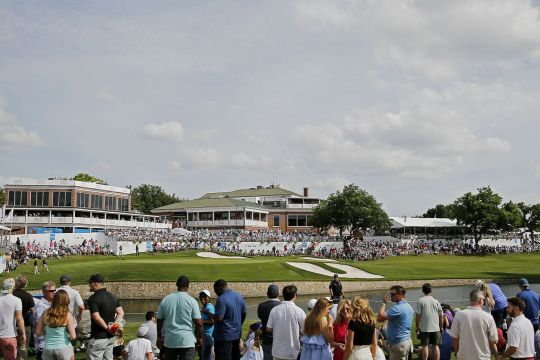
Photo by Michael Reaves/Getty Images
Golf now has a real plan to return — but it’s aspirational without expanded testing, puts an end to The Greenbrier for good, and might end up with Tiger Woods prepping for The Masters in Jackson, Mississippi.
Let’s start with the obvious positives. We’re all running thin on Netflix specials, on new books to read, whatever. After five-some weeks isolated and socially distanced with little to watch, everyone’s ready for sport to come back to our lives — in any format we can get it. Aggressively ahead of most other professional sports organizations on plotting a return, the PGA Tour announced Thursday morning a plan to resume play starting June 8.
The question isn’t if we want sports back. The person you know that loathes golf the most would probably settle for a sleepy Saturday afternoon 3M Open broadcast right now. It’s a matter if it’s right for the country and the world during this global pandemic.
Here’s what you need to know — and what to think about as we’re looking at this new schedule.
The Tour’s timeline to return is aggressive and will require extensive travel. Can that actually happen?
Dr. Anthony Fauci, who’s been a shining light of truth for many through this crisis, indicated just yesterday that there’s a path for sport to return this summer — playing without fans.
That’s not a problem for the Tour, which seems to be prepared to play events without galleries for several weeks. The return in Fort Worth at Colonial won’t feature anyone in the grandstands, nor will any event through the Rocket Mortgage Classic on the weekend of July 4 in Detroit. PGA of America president Seth Waugh has said the organization is prepared to play the August PGA Championship without fans at Harding Park in San Francisco. At the very least, the governing bodies are prepared for the reality that fans may not be present at golf tournaments for a long time.
But there’s one other item Fauci noted in his comments earlier in the week that would be a massive problem for the Tour’s proposed schedule — keeping the players quarantined, isolated, and restricted to a small geographic area.
“There’s a way of [returning].” Fauci told Snapchat on Tuesday when speaking about a possible return for Major League Baseball. “Nobody comes to the stadium. Put [the players] in big hotels, wherever you want to play, keep them very well surveilled. ... Have them tested every single week and make sure they don’t wind up infecting each other or their family, and just let them play the season out.”
Golf has an advantage other sports don’t in this struggle to return to normalcy. The game is by nature spread out over hundreds of acres, outdoors. It’s not a contact sport, save for interaction with a caddie. That makes it relatively easy to still adhere to six-feet-apart social distancing guidelines during competition.
But the PGA Tour’s proposed schedule would struggle to meet the standard Fauci and others advise of sequestering athletes in a defined localized area. The MLB, NBA, EPL, and other leagues have all reportedly floated ideas to isolate players to complete seasons in places like Las Vegas or Arizona. The Tour is not doing that here. If regional and local containment becomes a priority and testing cannot increase to the capacity needed, is it safe to have professional golfers and a traveling cadre of broadcasters, support staff, and others? Despite the announced plans, the Tour seems to at least be keeping that in mind.
PGA Tour exec Andy Pazder expresses confidence that increased testing availability will facilitate a June re-start of competition but adds, "We will play only when we are certain that it is safe and responsible to do so."
— Will Gray (@WillGrayGC) April 16, 2020
RIP to the Greenbrier event, which is gone from the schedule for good
The casualty of all the schedule shuffling? The Greenbrier, which has been bumped around several times in recent years, is off the schedule for good.
There’s perhaps no full-field PGA Tour event in the modern era that’s had as weird and circuitous a history as the West Virginia event. Added to the schedule in 2010 to replace the longstanding, fan-favorite Buick Open, the tournament opened with a bang with Stuart Appleby’s stunning final-round 59 to beat Jeff Overton. That started a nice run, including appearances by Tiger Woods and Phil Mickelson, even during an often-shifting July date.
Then came the devastating floods that hit West Virginia in 2016, forcing the cancellation of the event, from which the tournament never really recovered. The later arc of the event brought us the somewhat bizarre, flag-loving A Military Tribute At The Greenbrier name. The final death knell to the relationship between the resort and the Tour may have been the choice to move the event from July to September as part of the 2019 schedule changes — which no matter the spin, is a less desirable date for a golf event opposite football.
The Tour’s contract with the Greenbrier ran through 2026, but both sides were ready to walk. So, goodbye to Old White and summer in West Virginia. You were nothing if not weird.
The off-season for pro golfers is suddenly, uh, right now
We often joke about the year-round, never-ending professional golf schedule. The true 2019-20 PGA Tour schedule provided all of a couple of weeks off between the season-ending Tour Championship and the aforementioned September Greenbrier. Still, there’s a usual ebb-and-flow to things for top players. Start ramping up the schedule slowly in January, February, March to prepare for the usual summer major months, then play sparingly in fall downtime.
That won’t be happening this year. The reshuffling has created a back-loaded 2020 schedule with odd rhythms and weird travel patterns leading into majors for the top players. Consider this example: If a player wants to make a couple of pre-Masters warm up starts, but doesn’t want to play the week prior in Houston, they’ll have to leave the country. The entire lead-up to the biggest tournament of the year features events in Korea, Japan, China, and Bermuda — during a global pandemic! Lots of players aren’t going to love that, probably Woods included.
The FedExCup Playoffs-U.S. Open combo in August-September will cause weirdness, too. What if Jordan Spieth, now 110th in the FedExCup standings, doesn’t qualify for the BMW Championship? Does he opt to play on the other side of the country the week before the U.S. Open? Come in with a month off ahead of a major? Or look somewhere else — like another Tour, for a start? It’s bizarre to even consider, but we’re going to see oddities in individual schedules like this all year.
Here’s the rest of the full, revised schedule — for now.
Revised 2019-20 PGA Tour Season schedule:
NO FANS June 8-14: Charles Schwab Challenge, Colonial Country Club, Fort Worth, Texas
NO FANS June 15-21: RBC Heritage, Harbour Town Golf Links, Hilton Head, South Carolina
NO FANS June 22-28: Travelers Championship, TPC River Highlands, Cromwell, Connecticut
NO FANS July 2-July 5: Rocket Mortgage Classic, Detroit Golf Club, Detroit
July 6-12: John Deere Classic, TPC Deere Run, Silvis, Illinois
July 13-19: the Memorial Tournament presented by Nationwide, Muirfield Village Golf Club, Dublin, Ohio
July 20-26: 3M Open, TPC Twin Cities, Blaine, Minnesota
July 27-Aug. 2: World Golf Championships-FedEx St. Jude Invitational, TPC Southwind, Memphis
July 27-Aug. 2: Barracuda Championship, Tahoe Mountain Club (Old Greenwood), Truckee, California
Aug. 3-9: PGA Championship, TPC Harding Park, San Francisco
Aug. 10-16: Wyndham Championship, Sedgefield Country Club, Greensboro, North Carolina
Aug. 17-23: The Northern Trust, TPC Boston, Norton, Massachusetts
Aug. 24-30: BMW Championship, Olympia Fields Country Club (North), Olympia Fields, Illinois
Aug. 31-Sept. 7: Tour Championship, East Lake Golf Club, Atlanta
And because the Gregorian Calendar stopped mattering on the PGA Tour schedule a few years ago, here’s where the new “season” begins in the fall. If you’re going by the definition of “season,” next year’s Tour schedule will have six majors in it, if all goes according to this plan.
2020-21 PGA Tour Season Schedule (fall portion):
Sept. 7-13: Safeway Open, Silverado Resort and Spa North, Napa, California
Sept. 14-20: U.S. Open, Winged Foot Golf Club, Mamaroneck, New York
Sept. 21-27: Ryder Cup, Whistling Straits, Kohler, Wisconsin
Sept. 21-27: Corales Puntacana Resort & Club Championship, Corales Golf Club, Punta Cana, Dominican Republic
Sept. 28-Oct. 4: Sanderson Farms Championship, Country Club of Jackson, Jackson, Mississippi
Oct. 5-11: Shriners Hospitals for Children Open, TPC Summerlin, Las Vegas
Oct. 12-18: The CJ Cup, Nine Bridges, Jeju Island, Korea
Oct. 19-25: Zozo Championship, Accordia Golf Narashino Country Club, Chiba Prefecture, Japan
Oct. 26-Nov. 1: World Golf Championships-HSBC Champions, Sheshan International Golf Club, Shanghai, China
Oct. 26-Nov. 1: Bermuda Championship, Port Royal Golf Course, Southampton, Bermuda
Nov. 2-8: Houston Open, Memorial Park Golf Course, Houston
Nove. 9-15: Masters Tournament, Augusta National Golf Club, Augusta, Georgia
Nov. 16-22: The RSM Classic, Sea Island Resort (Seaside and Plantation), Sea Island, Georgia
Nov. 23-29: Open week (Thanksgiving)
Nov. 30-Dec. 6: Mayakoba Golf Classic, El Camaleón Golf Club, Playa del Carmen, Mexico
Nov. 30-Dec. 6: Hero World Challenge, Albany, New Providence, Bahamas
Dec. 7-13: QBE Shootout, Tiburón GC, Naples, Florida
Dec. 14-20: PNC Father-Son Challenge, The Ritz-Carlton Orlando, Grande Lakes, Orlando
0 notes
Text
What the Heck IS Magic, Anyway?
I’m going to do my writing for the #2019GrimoireChallenge just directly on my blog for the time being (I didn’t want to stick these in the middle of my OBOD course work). But anyway! The first research/journal prompt for Week 2 was Magic: what it is and how it works.
The answer to this will literally differ vastly depending upon who you talk to. So for sake of not ruffling feathers, etc. etc. this is my gnosis of the above topic.
Magic is, to put it most simply, the act of changing, attuning or manifesting something within one’s self, the world, or the web of fate and circumstance.
Now, I know that doesn’t really seem very simple at all, but stick with me for a few more paragraphs. Magic, for me, can be sort of split up as thus: the magic of life/being/awe, the magic of working change within one’s self-which can be accomplished in a number of ways, and the magic of working change in the web of fate/circumstance/etc.
The first is those moments that are magic- looking up and being taken aback by an inky sky full of stars, the way a cold wind hits you as it rips over the bay dragging a storm behind it, the way a song can make the hair on your arms or neck stand on end, or the gentle peace and awareness of wind whispering through the trees. This also applies to the magic of creating, of giving life to inspiration as it strikes us. Creating art, music, poetry, prose, gardens, literal LIFE, all of those things are magic, and they aren’t thought out spells or carefully constructed rituals, they are just the parts of life that make our lives feel, well, lively.
The second, working magic within one’s self is identifying parts of the self that need improvement, love, healing, expression, whatever, and giving them what they need in order to become more full, healthy, and grounded people. You can accomplish this with spells and rituals- by all means, those things are powerful psychological tools that help us to mentally make the shifts we need in order to actually make the changes we need in our life. This can be brought about through meditation and visualization, or through the very very mundane act of sitting down, goal setting, and getting your shit together. It’s self-alchemy, and in many ways I think it’s more important than the third type of magic.
Working magic to affect the world about me, change the web of fate, etc. is what most people usually think about when they think about spells and rituals. We raise energy and focus in order to will positive (or negative perhaps) outcomes into being. Spells work by utilizing tools: herbs, crystals, candles, etc. which energetically align with our desires, and help us to focus our intentions.
Magic in the second and third instance operates on the idea that like attracts like, if we are positive and put out our intention, the Universe will provide us with just that. If we focus on becoming a better, healthier person, and put energy into taking the steps to accomplish that, we become better, healthier people. It’s a matter of creating the changes first on a small level- in our minds, and then sending the energy out into the universe, like a ripple in a pond which (hopefully) affects the change we want to occur.
#magic#witchcraft#2019 gc#2019 gc week 2#2019 grimoire challenge week 2#january week 2#2019 gc january week 2#patch-workcrow#druidry#druid#spells#spellcraft#what is magic#pagan#paganism
5 notes
·
View notes
Text
Brie, blue
09 January 2019
The C&T was rammed this week, in stark contrast to last week’s kick-off into 2020. Eleven teams were present, including the Rev Alex’s Men’s Meet Up team, which was so large it had to split off into two, God Squad and 2nd Eleven (of which there were less than eleven!).
QM welcomed back regular teams, including Last Again, Hotspur Trio and GCHQ, among others. Several non-regulars also pitched in. Pluffs were a significant team member down; and GC men’s team [Variable Name] rediscovered that strength does not lie in numbers/oversized teams.
QM was consternated if not ruffled to find that several erudite teams had never heard of blue brie. The mensa question and the dingbat were challenges that occupied teams until well into Collect-Up time. After answers were shouted, 2nd Eleven were declared The Winners and subjected to a round of applause. On her post-triumphal rounds, however, QM discovered that God Squad were unhappy with their final score, and on checking their paper, a Steward’s Enquiry was held. This upheld their complaint and placed them joint first with 2nd Eleven, and a Tie-Breaker was therefore declared. As luck (and inside knowledge about the average distance in miles between the Earth and the Moon) would have it, the Tie-Breaker was won by God Squad, who were, to put it mildly, positively jubilant with many hurrahs and much finger-pointing.
By the time QM got around to digging out her phone for Winner’s picture, however, most of God Squad had absconded, presumably to better offers. The pic therefore shows the (now reunited) Men’s Meet Up, and you can see the Rev still celebrating and positively jubilating.
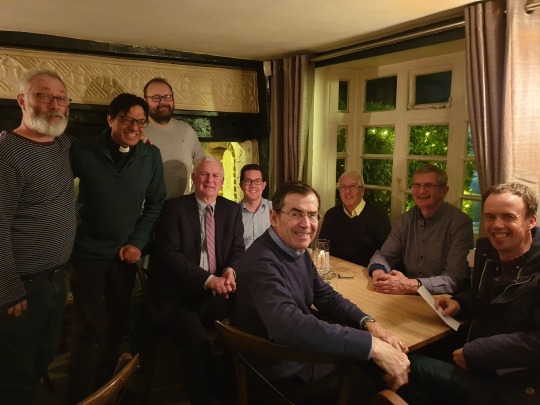
Winners: God Squad (standing) and 2nd Eleven
On the Podium
1st place: God Squad – 51 points (Tie-break winners)
2nd place: 2nd Eleven – 51 points
3rd place (joint at 49 points each): Hobbers Mascots; Bad Losers; Non-Blondes & Howard.
QM joined her former team-mates, the Pluffs, who were reminiscing about our former Quiz Master, Alan, and how all miss his banter and general happy presence. As each fell into their own thoughts, we inadvertently held a minute’s silence. To Absent Friends.
See you all next week!
Have a go at the Quiz:

Acknowledgements: https://www.mensa.org/; http://www.kensdingbats.co.uk/dingbats
0 notes
Text
March 2020 Travel Update!
Traveling is not really an option right now or for the foreseeable future, so why not look back on my trips taken in the last few years, since that’s been a theme of mine anyway.
2020 (2 Trips Taken, Many Trips Canceled or On Hold)
January (1): Home for my birthday. It was a really fun trip actually. Got to see LOTS of friends (Brian, Jimmy, Lauren, Nicole Leclaire, Jessie, Chris Tham) and go to HMB, the city, boat rides, Rickshaw, etc. It was really a “home-run” kind of weekend.
February (0): None!
March (1): Sequoia National Park with Jesse while Carina was on her Bachelorette trip to Napa. Ironically, this is the weekend that things started to get really crazy with COVID. Sequoia was gorgeous though, covered in snow once we got in far enough. For sure one of our most gorgeous NP trips/hikes.
The rest come down to nine trips that are either ticketed, scheduled, or were otherwise supposed to happen, but now we’ll just have to wait and see:
April (2): Big Bear [postponed to July], and New York for work [postponed or canceled].
May (2): Bay Area [for work actually, postponed or canceled] and Caymans in late May [TBD].
June (1): New York for Dan’s wedding [TBD].
July (1): Big Bear, rescheduled from April.
August (1): Bachelor party weekend, likely to San Diego, likely still happening unless things get much worse from here.
September: no travel plans, given our wedding!
October: none
November (1): Honeymoon - details, locations and all plans TBD.
December (1): Likely Massillon, but no plans at this time. Too early.
2019 (12 Trips)
January (1): Chicago with Carina for New Year’s! GOT ENGAGED!!
February (1): New York for work right after Grammys, stayed a couple extra days as Carina was supposed to join but couldn’t due to flight troubles.
March (0)
April (3): Atlanta for LMA, annual Big Bear trip for Jesse’s birthday, then Jesse’s bachelor party trip at the end of the month which was in Zion then Vegas.
May (2): Home at the beginning of the month to visit Dad, then Ensenada last weekend for Jesse and Katie’s wedding!
June (1): Home at the end of the month with Carina, saw lots of friends.
July (1): Singapore and Bali at the end of the month with Carina! First trip to Asia! Amazing!
August (1): Yellowstone at the end of the month with Dad and Carina! The first time for both of them!
September (1): went to the bay for the weekend for Carina’s launch party. Actually had a super nice time in the city and a full day of walking around and exploring. It was a gorgeous day and one for the books.
October( 0): None! But my dad came down to visit which was nice.
November (0): None! Had a lovely, rainy, cold (as it should be) Thanksgiving at home - literally our home, our first time hosting! Carina’s family made it special.
December (1): Massillon for Christmas. We canceled Park City as the ski prices and hotel prices got ridiculous.
2018 (20 Trips)
January (2): Home for New Year’s with Carina, and New York for Grammys (followed immediately by DC)! New York was basically just hours after Kinsley was born!
February (2): DC for work with Doug, and Zion with Jesse, Anu and Akshay!
March (1): Home/SF with Jesse, Katie and Carina for St. Patrick’s Day!
April (2): New Orleans for LMA with Carina! And annual Big Bear trip for Jesse’s birthday.
May (2): Colorado for a video shoot with Sashi and the Caymans with Carina and her family!
June (2): DC for work with Doug (Capitol Crypto) and Home! (Giants game, big barbecue, pride at the park).
July (0):
August (3): Zion round 7 with Jesse (Observation Point), home to help dad after surgery, home again for Nicole’s wedding.
September (1): Albuquerque with Mom just for fun!
October (1): Ohio!! OSU and Massillon with Carina (for Homecoming but also a couple days in Massillon to introduce her).
November (2): Zion round 8, with Jesse and Carina (first Angel’s Landing ascent of 2018 and first for Carina in general). And ICELAND!!! Plus home for a day after Iceland as an extended layover.
December (2): Home for Christmas then Massillon for Christmas! (We had light attendance this past year though).
2017 (22 Trips)
January (2): Home for New Year’s, and Washington, DC for my birthday with Carina!
February (1): Arizona road trip (through Page) with Carina.
March (2): Zion, Arches, and Bryce with Jesse, Katie, and Carina! And Vegas for LMA.
April (3): DC & New York for work, Big Bear round 2 for Jesse’s birthday, and the bay with Carina.
May (3): Vegas for Mother’s Day with Jenn, Brian, and Carina, NY & DC for work (again just a month later), and Denver/ The Rockies with Jesse, Katie, and Carina!
June (2): Pismo Beach with Carina and her friends, then Kings Canyon & Sequoia with Jesse (and we saw a bear).
July (2): Amsterdam & Bruges with Carina (what?!) and Santa Barbara with Jesse and Anu.
August (3): The bay for OSU buds, Jenn & Brian’s announcement, and Giana’s going away party. Then Cabo with Carina, Parthiv and his friends, then the bay again for Mom & Dad’s birthdays.
September (0): None!
October (2): Zion round 5 with Jesse, and upcoming: the bay with Dan & Chrystal.
November (1): Home for Thanksgiving.
December (1): Massillon for Christmas! (No trip home for Christmas? We might have lumped that into the Thanksgiving visit).
2016 (19 Trips)
January (3): Home for New Year’s, Portland with Tina, and Grand Canyon/ Utah with Jesse.
February (0): None!
March (2): Joshua Tree with Jesse, and home.
April (3): Austin for LMA, Big Bear for Jesse’s birthday, and home with Jesse, Katie, and Lexie!
May (1): New York City for work right after Jenn’s wedding!
June (2): Borrego Springs with Carina and Seattle with Carina!
July (2): Scottsdale for the 4th and Yellowstone with Jesse!
August (1): Home with Carina.
September (2): Banff (!!!) with Carina and Homecoming at OSU.
October (1): Home to hang with Dad & Mom post-surgery and injury.
November (1): Zion round 3 with Jesse.
December (1): Massillon! [We did our Christmas in Riverside].
2015 (18 Trips)
I had set out to travel at least once per calendar month.
January (2): Home for New Year’s, and Chicago with Giana, Janelly, & Lauren.
February (1): Colorado with Jesse.
March (1): Bay Area with Lina.
April (1): Arizona (Sedona & GC NP) with Jesse.
May (1): Seattle with Jesse and Dan.
June (1): Zion [Round 1!] with Jesse.
July (2): Rancho Mirage, then Home for a week after M&R/ before MSK.
August (2): Zion Round 2 with Jesse, then the bay for Elyse’s wedding.
September (1): Tennessee with Jesse.
October (2): Homecoming at OSU, then New York City for MSK.
November (2): Boston! And Cabo!
December (2): Home for Christmas and Massillon for Christmas.
0 notes
Text
Stock market news live: Stock futures jump after China announces plans to cut tariffs on $75 billion in US goods
U.S. stocks shook off fears of the coronavirus for another day chasing European and Asian equities higher during Thursday’s session.
—
11: 01 a.m. ET: Casper Sleep opens at $14.50 per share after pricing IPO at $12 apiece
Shares of mattress company Casper Sleep (CSPR) opened for trading on the New York Stock Exchange at $14.50 per share. This was 21% above its initial public offering price of $12 per share set Wednesday evening.
Casper’s IPO price of $12 per share had been at the low end of its expected range. Wednesday’s pricing of 8.35 million shares raised just over $100 million for the company.
At the highs of Thursday’s session just after shares began trading, Casper’s stock surged to as much as $15.39 per share, giving it a market capitalization of $611 million. That valuation has sunk considerably from its last private valuation, which at $1.1 billion had designated Casper a “unicorn” with a market value north of a billion dollars.
In its prospectus, Casper revealed a net loss of $67 million on revenue of $312 million from January through September 2018.
—
9: 34 a.m. ET: S&P 500, Dow hit record highs after China says it will roll back some tariffs
U.S. stocks held onto gains into market open, with each of the three major indices advancing just after the opening bell. Both the S&P 500 and Dow rose to record highs.
Here were the main moves in markets, as of 9: 34 a.m. ET:
S&P 500 (^GSPC): +0.23% or +7.65 points to 3,342.34
Dow (^DJI): +0.26% or +74.98 points to 29,365.83
Nasdaq (^IXIC): +0.15% or +16.02 points to 9,524.70
Crude oil (CL=F): -0.3% or -0.15 to 50.60 a barrel
Gold (GC=F) +0.29% or +4.50 to 1,567.30 per ounce
—
7: 52 a.m. ET: Twitter’s stock jumps 8% in early trading after topping 4Q sales, user growth expectations
Twitter (TWTR) posted fourth-quarter revenue and user growth that exceeded consensus expectations, driven by a jump in ad sales from the company’s home market. Fourth-quarter earnings and guidance for the current quarter, however, were short of consensus estimates.
Here were the main metrics from the report, compared to consensus estimates compiled by Bloomberg:
Revenue: $1.01 billion vs. $994.5 million expected
Adjusted earnings per share: 17 cents vs. 28 cents expected
Average monetizable daily active users: 152 million vs. 148.1 million expected
Twitter’s average monetizable daily active users (mDAU) jumped 21% in the fourth quarter, more than doubling the 9.6% gain in mDAU the company posted in the same quarter last year. For the last three months of 2019, U.S. mDAU grew 15% to 31 million, while international mDAU grew 22% to 99 million.
READ MORE
—
7: 51 a.m. ET: Yum Brands posts mixed 4Q results
Yum Brands (YUM), the parent company of fast food restaurants including Taco Bell, posted fourth-quarter earnings that missed expectations and disappointing sales at its Pizza Hut chain. Shares were down more than 2% to $104.49 each during the pre-market session.
Here were the main metrics from the report:
Revenue: $1.69 billion vs. $1.65 billion expected
Adj. earnings per share: $1.00 vs. $1.13 expected
Worldwide same-store sales: +2.0% vs. +2.1% expected
KFC same-store sales: +3% vs. +2.9% expected
Taco Bell same-store sales: +4% vs. +3.1% expected
Pizza Hut same-store sales: -2% vs. 0% expected
READ MORE
—
7: 45 a.m. ET: Stock futures point to fourth straight session of gains after China announces reciprocal tariff reduction
Contracts on each of the S&P 500, Dow and Nasdaq were on track for a fourth consecutive day of gains, wiping away last week’s declines driven by fears over the coronavirus outbreak.
A statement from China’s Ministry of Finance asserting that the country would halve tariffs on about $75 billion worth of U.S. imports on Feb. 14 also helped boost sentiment. On the same date, the U.S. is also due to lower tariffs on Chinese imports, as part of the previously agreed-upon phase one trade deal between the two countries.
China’s tariff reduction will lower the rate on some tariffs to 5% from 10% previously, and others from 2.5% from 5%.
Here were the main moves during the pre-market session, as of 7: 45 a.m. ET:
S&P futures (ES=F): 3,347.00, up 12 points or 0.36%
Dow futures (YM=F): 29,356.00, up 115 points or 0.39%
Nasdaq futures (NQ=F): 9,424.50, up 43 points or 0.46%
Crude oil (CL=F): $51.19 per barrel, up $0.44 or 0.87%
Gold (GC=F): $1,568.30 per ounce, up $5.50 or 0.35%
NEW YORK, NY – FEBRUARY 04: Traders work on the floor of the New York Stock Exchange (NYSE) on on February 4, 2020 in New York City. The markets rebounded after a fall last week on coronavirus fears. (Photo by Eduardo Munoz Alvarez/Getty Images)
—
Follow Yahoo Finance on Twitter, Facebook, Instagram, Flipboard, LinkedIn, and reddit.
Find live stock market quotes and the latest business and finance news
%
from Job Search Tips https://jobsearchtips.net/stock-market-news-live-stock-futures-jump-after-china-announces-plans-to-cut-tariffs-on-75-billion-in-us-goods/
0 notes
Text
Tour de France Stage Reference Guide

Here’s the 2021 Tour de France route and reference guide. Yes the Tour de Suisse is still on and so is the Tour of Slovenia but all roads lead to Brittany at the moment.
There’s a profile of every stage with a quick summary of the day’s course. You’ll also find references for time bonuses, the points scale for the green and polka-dot jersey, time cuts, prize money and plenty more. If you want to come back between now and July, just visit inrng.com/tour or click on the Tour guide from the menu above.
Route Summary
Three summit finishes, seven likely sprint finishes and two solo time trials makes the 2021 Tour route look a bit more traditional. It is a reset on the Tour’s trend for more mountains and fewer time trials and there’s the most amount of TT kilometres since 2013 but that’s the comparison, a route like 2013 or perhaps 2016 rather than anything more retro. All grand tours are backloaded but this one especially so with only a quick dash in and out of the Alps before a hard final week which spends most of the time in the Pyrenees and concludes with a time trial in the Bordeaux vineyards.
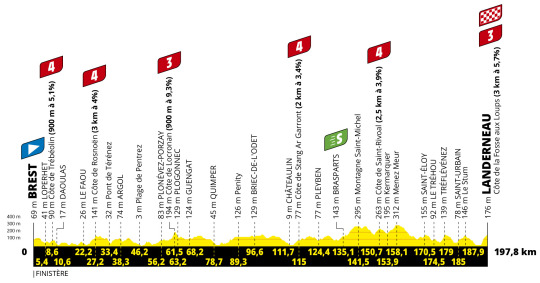
Stage 1 – Saturday 26 June
A very Breton stage that’s got big cities and wild coastlines. It’s made for punchy riders with a 3km uphill finish that’s narrow and steep at the start, it opens up the cast of contenders from the most athletic sprinters to the overall contenders with plenty of punchy riders in between but it feels like they’ll all be second to Mathieu van der Poel.

Stage 2 – Sunday 27 June
Another hilly day in Brittany with an uphill finish, this time at Mûr-de-Bretagne, a regular spot for the Tour in recent years. It’s not a GC day but the last time the Tour visited there were splits between the contenders and the first 50 riders were spread over a minute so it’s a hectic finale.
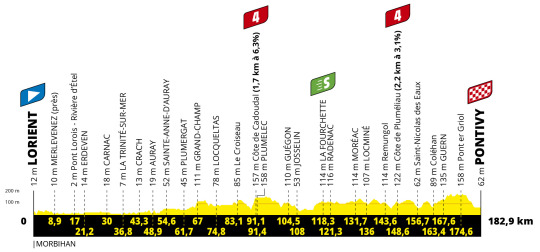
Stage 3 – Monday 28 June
One for the sprinters but this is no dragster course, it’s full of twisting, narrow roads.
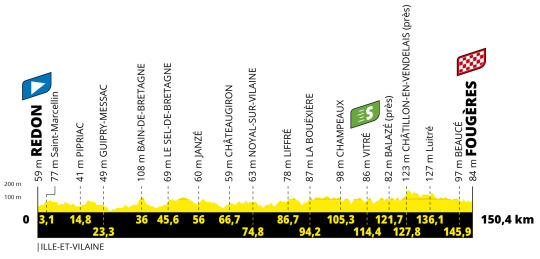
Stage 4 – Tuesday 29 June
Another for the sprinters.
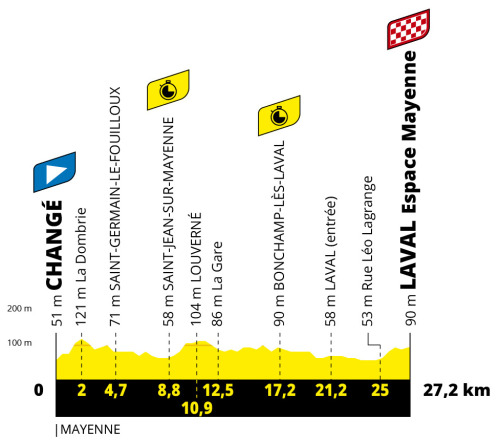
Stage 5 – Wednesday 30 June
The Tour has an unofficial rule for course design these days: no more than two sprint stages in a row otherwise it’s boring. So what to do when you’re crossing a flat part of France? Have a TT. This is a big day for the overall classification. To call this a hard course is excessive but the route’s as hilly as possible given the flat ground.
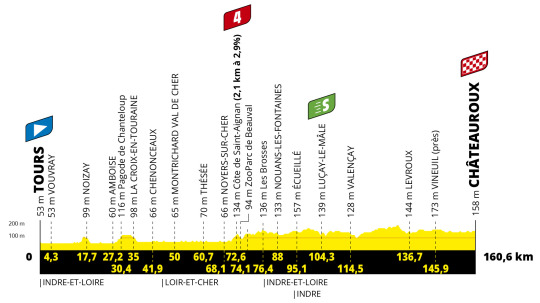
Stage 6 – Thursday 1 July
Another one for the sprinters across flat terrain to the sleepy town of Châteauroux, famous for… well not too much. Actor Gérard Depardieu was born here and Mark Cavendish took his first ever Tour de France stage here in 2008… and won again when the race returned in 2011.

Stage 7 – Friday 2 July
The longest stage of the race and a hard finish across the Morvan, a small mountain range, with the Signal d’Uchon as the focal point, a tough climb after 220km.
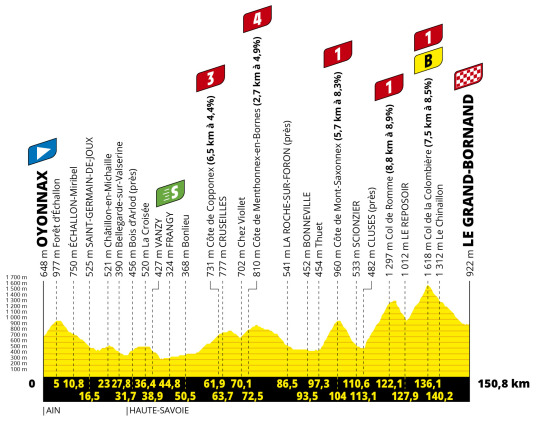
Stage 8 – Saturday 3 July
The first Alpine stage and there’s plenty packed into 150km. Uphill out of the Jura mountains, across the foothills and then a “new” climb via the Gorges du Bronze labelled Mont-Saxonnex that’s harder than suggested. Then straight into the steep Romme-Colombière combo before a fast descent to the finish.

Stage 9 – Sunday 4 July
Remember the 2019 Tour de France and the landslides that blocked roads for the final two mountain stages? This stage makes amends, crossing where the race couldn’t. This 145km dash is a scenic Alpine stage where the mountains competition labels don’t tell the story, the Roselend is much harder than Domancy, the Col du Pré is hard but surely not HC-hard? The final climb is much of the Col de l’Iseran before then a turning to Tignes, a long and gradual drag up to a high altitude finish that will suit stronger teams rather than lone climbers.

Stage 10 – Tuesday 6 July
The Tour leaves the Alps to the relief of the sprinters who should get their reward in Valence.

Stage 11 – Wednesday 7 July
The Ventoux one-two with the mountain climbed twice, first from the gentlest side via Sault, and a practice down the Cresta Run-style descent to Malaucène, then the traditional route from Bédoin before the downhill to Malaucène again.
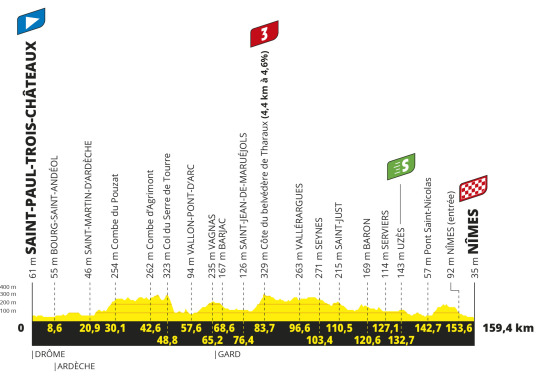
Stage 12 – Thursday 8 July
A start in Saint-Paul-Trois-Châteaux which sounds charming, evoking images of an old town with three castles and it is nice… but local views can be dominated not by castles but by the giant cooling towers of the nuclear power plant. A likely sprint stage with the usual caveats if the crosswinds blow. Watch out for the unmarked climb out of the Gordon valley gorge with 10km to go.

Stage 13 – Friday 9 July
Another sprint stage with the same caveats about crosswinds before the finish in Carcassonne, the town famous for its medieval-style ramparts.

Stage 14 – Saturday 10 July
If you had to pick one stage to ride as a tourist it’d be this for the scenery and the fun of the course in a corner of France that the Tour doesn’t use enough. Race-wise it’s a great day for the breakaway.
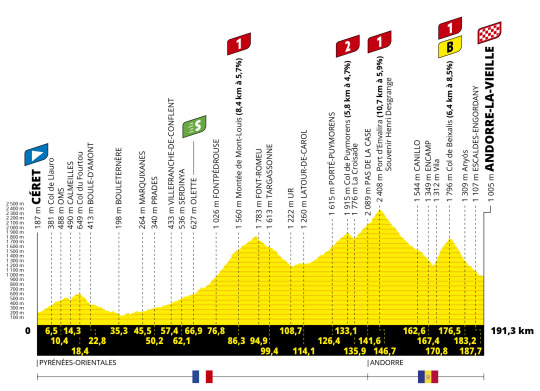
Stage 15 – Sunday 11 July
A visit to Andorra via some big, long climbs before the sharp ascent of the Col de Beixalis, a staple of the Vuelta in recent years, and a descent back to down. There’s a rest day in Andorra.

Stage 16 – Tuesday 13 July
Out of Andorra but rather than climbing out, it’s a downhill run to spare anyone who got their rest day wrong (think Anquetil in 1964 and the sangria-méchoui story). Three hard passes are in the way, the average percentages don’t sound hard but they’re flattered and flattened by gentle starts to each climb. There’s a late climb 8km from the finish but it’s more ramp than wall.

Stage 17 – Wednesday 14 July
A dash across the plains before colliding with the Peyresourde, a big boulevard of a climb and a fast descent into the twisty climb of Val Louron-Azet and an even twistier descent. Then comes the “new” Col du Portet, the upper section was tarmacked in 2018 just in time for the Tour de France’s visit, a day when Nairo Quintana won and Chris Froome cracked. It’s now the highest paved pass in the French Pyrenees and a very hard climb.

Stage 18 – Thursday 15 July
Short in distance, big on altitude with the Tourmalet and then Luz Ardiden summit finish, a big day for the mountains competition.
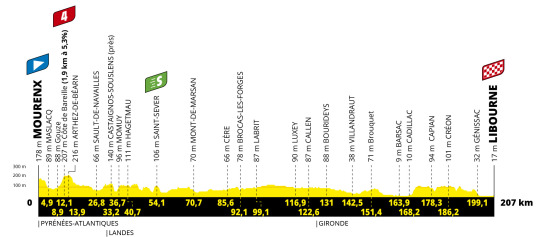
Stage 19 – Friday 16 July
A sprint stage, in the past the race would have gone to the nearby city of Bordeaux but the townhall’s less keen on the Tour, so Libourne gets the publicity.

Stage 20 – Saturday 17 July
A time trial with a route that reads like a wine menu, this 30km course rides past many famous vineyards and châteaux.
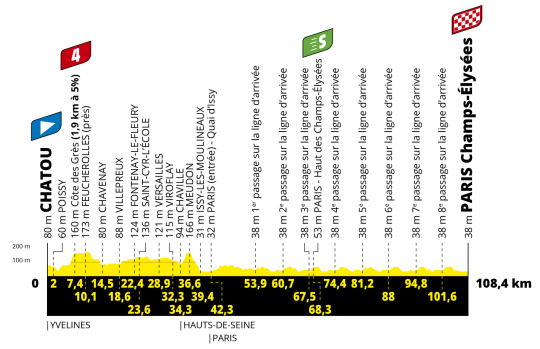
Stage 21 – Sunday 18 July
The usual 60km parade that mutates into a 60km criterium and the finish on the Champs Elysées. Some riders will be in a hurry as there’s a flight waiting at Charles de Gaulle airport to take them to Tokyo.

The Jerseys
Yellow: the most famous one, the maillot jaune, it is awarded to the rider with the shortest overall time for all the stages added together, the rider who has covered the course faster than anyone else. First awarded in 1919, it is yellow because the race was organised by the newspaper L’Auto which was printed on yellow paper. Today it is sponsored by LCL, a bank. There are time bonuses of 10-6-4 seconds for the finish of each stage except the time trials. There are also 8-5-2 seconds at the bonus sprints marked “B” on the profiles above, typically atop various mountain passes.
Green: the points jersey, which tends to reward the sprinters. Points are awarded at the finish line and at one intermediate point in the stage and the rider with the most points wears the jersey. It is sponsored by Skoda, a car manufacturer
Flat stages (Stages 1,2,3,4,6,10,12,13,19,21) 50-30-20-18-16-14-12-10-8-7-6-5-4-3 and 2 points for the first 15 riders
Hilly finish / Medium mountain stages (Stages 7,14,16): 30-25-22-19-17-15-13-11-9-7-6- 5-4-3-2 points
Mountain Stages + individual TT (Stages 5,8,9,11,15,17,18,20) : 20-17-15-13-11- 10-9-8-7-6-5-4-3-2-1 points
Intermediate sprints: 20-17-15-13-11-10-9-8-7-6-5-4-3-2-1 points
Polka dot: also known as the “King of the Mountains” jersey, points are awarded at the top of categorised climbs and mountain passes, with these graded from the easier 4th category to the hors catégorie climbs which are so hard they are off the scale. In reality these gradings are subjective. Again the rider with the most points wears the jersey. It is sponsored by Leclerc, a supermarket.
Hors Catégorie (4 in total): 20-15-12-10-8-6-4-2 points
Category 1 climbs (13): 10-8-6-4-2-1 points
Category 2 (9): 5-3-2-1 points
Category 3 (10): 2-1 points
Category 4 (23): 1 point
White: for the best young rider, this is awarded on the same basis as the yellow jersey, except the rider must be born after 1 January 1996, ie aged 25 or under. It is sponsored by Krys, a retail chain of opticians
If a rider leads several classifications, they take the most prestigious jersey for themselves and the number two ranked rider in the other competition gets to wear the other jersey. For example if a rider has both the yellow jersey and the mountains jersey they’ll wear yellow while whoever is second in the mountains jersey will sport the polka dot jersey. If a rider has all the jerseys the priority yellow, green, polka dot then white.
There’s also a daily “most combative” prize awarded every day to the rider who has attacked the most or tried the hardest. It is a subjective prize and awarded by a jury. The rider gets to stand on the podium after the stage and wear a red race number the next day. There will be a final Supercombatif prize with involvement from the jury and social media. It is sponsored by Antargaz, a bottled gas company.
Timekeeping
Normally a one second gap on the finish line is needed to separate groups in a finish but for Stages 3,4, 6, 10, 12, 13, 19 and 21, the likely sprint stages, three seconds is needed for a split in the field. The three kilometre rule doesn’t apply on Stages 1, 2, 5, 9, 17, 18 and 20.

Time Cuts
Stages are given a coefficient rating from 1-6, look up the stage in question in the table above. Then see the average speed for the day’s winner and look up the corresponding line below.

The unmissable stages
There’s always something to watch in the Tour but there are some stages that matter more than others. If you need to plan ahead, here are some suggestions:
Stage 1: the prestige of the yellow jersey awaits the winner
Stage 7: the longest stage, don’t tune in all day but the finish could be interesting
Stage 8: into the Alps
Stage 9: more Alps
Stage 11: Mont Ventoux
Stage 14: the fight to get in the breakaway and then to see how the finish plays out
Stage 15: the Beixalis climb towards the finish in Andorra
Stage 17: the Col du Portet summit finish
Stages 18: the Tourmalet and Luz Ardiden summit finish
Stage 20: the final time trial to decide the GC
TV Guide
Every stage will be shown live from start to finish. Think of it like the radio, something to have in the background, or tune in from time-to-time via your phone in case there’s early action. The daily finish time varies between 5.00pm-5.40pm CEST.
The race will be broadcast on a variety of channels around the world. There is no free stream on the internet but you will find a feast of legitimate feeds from local broadcasters and international sources like Eurosport-GCN.

The Prizes
Each day on a normal stage there’s €11,000 for the winner, €5,500 for second place and a decreasing scale down to a modest €300 for 20th place
For the final overall classification in Paris, first place brings in €500,000 and the Sèvres porcelain “omnisports trophy”, awarded “in the name of the Presidency of the French Republic”. The full breakdown is €500,000 for first place, €200,000 for second place, €100,000 for third place and then €70,000, €50,000, €23,000, €11,500, €7,600, €4,500, €3,800, €3,000, €2,700, €2,500, €2,100, €2,000 €1,500, €1,300, €1,200 and €1,100 for 19th place. €1000 for 20th-160th overall
There are other pots of money available in the race:
€500 a day to whoever wears the yellow jersey, €300 for the other jersey holders
€25,000 for the final winner of the green and polka dot jerseys
€20,000 for the final winner of the white jersey
There’s also money for the first three in the intermediate sprint each day: €1,500, €1000 and €500
The climbs have cash too with the first three over an HC climb earning €800, €450 and €300 and lesser sums for lesser climbs
The highest point in the race sees a prize when on Stage 15 the Henri Desgrange prize is awarded at the top of the Port d’Envalira and is worth €5,000, the Jacques Goddet prize is also €5,000 for the first over the Tourmalet
The “most combative” prize is awarded and worth €2,000 each day, the “Super combative” prize is awarded in Paris and the winner collects €20,000.
There’s also a team prize with €2,800 awarded each day to the leading team on the overall, €50,000 for the final winners in Paris. Note the team prize is calculated by adding the time of the best three riders each day rather than the best three on GC. For example if a team has riders A, B and C make the winning break one day then their times for the stage are taken and added together. If riders X, Y and Z on the same team go up the road the next day, their times are taken. So it’s the times of a team’s best three riders each day as opposed to the best three riders overall.
The total prize pot is €2,288,450, meagre for an event of this scale but remember that unlike, say tennis or golf, pro cyclists are salaried and prize money instead is incidental, a nice bonus on the side. Win a Tour stage and a rider might add a zero onto the salary, maybe more and so the race creates value rather than paying it. Anyway prize money is shared around the team (as well as levied and taxed) rather than pocketed by the winner, it’s quite possible the actual prize winner actually collects 5-10% of the headline sum. In addition, every team that starts gets paid €51,243 to cover expenses. And should a squad make it to Paris with six or more riders they stand to collect an additional €1,600 bonus for each rider.
Tour de France Stage Reference Guide published first on https://motocrossnationweb.weebly.com/
0 notes
Text

Tuesday’s prompt for Week 2 was “Witch, what does it mean to you? What type of witch are you?... Are there certain things you plan to learn as a witch? Certain goals you have?”
A witch, to me, is someone who practices witchcraft in some way: this can be spells and rituals, crystal healing, divination, artwork, devotional poetry, yoga, astrology, essentially the crafts of “The Craft”. A witch doesn’t follow a specific religious or spiritual path- they can be atheists, Christian, Wiccan, polytheists of any sort, whatever. Witches and witchcraft, for my definition of the term aren’t bound necessarily by any specific religious or spiritual paradigm, but rather in the practice of those arts.
I personally identify first as a Druid and Bard. My reasons for this are:
1. “Witch” is often conflated with “Wiccan” and as my religious beliefs and practices are NOT Wiccan, I find it easier to start at Druidry. Druidry is a nature-based spiritual philosophy which may be applied to a number of different sects of Celtic (and Indo-European if you’re a member of the ADF) polytheism as well as other more mainstream religious movements. Druidry is focused upon connection, care and respect for the natural world, and expression of creativity- usually with an emphasis on song and poetry I’ve found. It’s usually very much entwined with Celtic cultural values of hospitality, the sacred landscape, good humor and wit, etc. and as a spiritual philosophy is not as necessarily concerned with the “craft” part of my witchcraft definition.
2. My personal practice is, usually a lot less “witchcraft-y” and more spiritual. I spend a great deal more time wandering the woods, contemplating the universe and meditating than I do crafting spells and reading cards. Therefore to call myself solely a witch feels a bit.. fake.
If I were to define the type of witch I was, I would probably call myself a Druid-Witch, or a Witch of the Wild Hunt. Longtime followers of my blog will have noticed (scattered through here and probably difficult to find because when the hell do I ever actually post personal / original content?) that I work specifically with a version of the Wild Hunt and their horned god leader. For me, this path is first and foremost concerned with nature (particularly storms and the forest), connecting with it, knowing my local environment and its cycles and patterns, etc. On another level, I feel very much called to be a bard for said hunter deity. A lot of my path is made up of composing devotional poetry and artwork, recording the tales I uncover as well as my own adventures and growth. This path includes studying patterns of the stars- not just astrology but the actual dance of the constellations across my own sky. It includes keeping my home, and my altar, as hearth for my familiar spirits to rest and to speak with me. It includes journeying through trancework and meditation with those spirits and gods. But it very very rarely includes ritual, spell work, etc. I do those things, but they aren’t the bulk of what makes up my practice.
Right now, my “witchy” goals include finishing up the OBOD Bardic Grade course, learning palmistry, and taking up Welsh and harp playing as devotional work for my gods. There’s a long way to go, but I’m eager to get started.
#2019 Grimoire Challenge#2019 gc#2019 gc week 2#2019 gc january week 2#january week 2#personal#personal path#personal gnosis#witch#witchcraft#pagan#paganism#druid#druidry#patch-workcrow#2019 grimoire challenge week 2
3 notes
·
View notes
Text
BREAKING NEWS: Mark Weinberger Is Done Being EY Global Chairman and CEO
Last night we were tipped off about a major announcement happening at EY this week, and we have received official confirmation of said announcement today by the firm: Mark Weinberger is stepping down as global chairman and CEO effective June 30, 2019.
EY confirmed what our source told us, that Weinberger told the firm’s leadership about his intentions this morning. EY’s Global Executive Board has apparently already been told as well. Our source said key clients were expected to be notified tomorrow and EY employees were to be told on Wednesday, but that has been hastened by our scoop.
An official announcement from EY on Weinberger stepping down will likely be released later this afternoon.
In a statement obtained by Going Concern, Weinberger said:
Today, I am announcing my decision to step down as Global Chairman and CEO, effective 30 June 2019. Being your Global Chairman and CEO has been one of the most rewarding experiences of my life and I will always be appreciative of the time I have had in this role.
EY and indeed the world has gone through tremendous changes during my tenure and I am proud and humbled by the opportunity I’ve had to play a leadership role in helping to navigate those changes. When I was elected Global Chairman and CEO in January 2012, we had a great team come together to develop a comprehensive strategy, which would take us through the turbulent and disruptive times we knew would be ahead of us. That strategy, Vision 2020, has served us exceedingly well, giving us a clear purpose, ambition and direction. Our commitment to Vision 2020 remains steadfast. And the Vision 2020+ transformative elements of our strategy will propel us forward, providing value to our clients and exciting opportunities for our people. Stepping down at the beginning of our financial year 2020 seems like the appropriate moment.
There is so much we’ve accomplished together: market-leading growth, improving audit quality, driving cutting-edge innovation, building our brand, engaging and empowering our people, serving and enhancing our communities, and improving our diversity and inclusion. All of this has contributed to our role in Building a better working world. I know there is an even brighter future for EY and I’m excited to see what will be shepherded in by the next generation of exceptional EY leaders. I have great confidence in the extraordinary talent that extends across our organization.
I am sincerely grateful to each and every one of our now 270,000 people and countless alumni around the world – the success of EY has always come down to our people. Individually and collectively we have driven EY’s accomplishments. The best part of being Global Chairman and CEO, and what I will miss the most, is traveling around the world to meet with our people. I am amazed and humbled by the everyday acts of Building a better working world that I was privileged to see firsthand.
EY is a special place. We all work hard, and of course, we make tremendous sacrifices. Some days are better than others. We win some, we lose others. What is important is that we continue to grow and improve. I’ve learned that it’s not just what we accomplish, but how we accomplish things, and those we meet along the way that matter most. I have never taken for granted the incredible talent and generosity of the people I have traveled this journey with. And I have never lost sight of the significance we place on our commitment to clients, regulators, each other and the capital markets we serve. I have grown immeasurably – personally and professionally – since becoming a member of the EY family. I firmly believe that whenever you join EY, however long you stay, the exceptional experience lasts a lifetime. I know it will for me.
I am grateful for the distinct honor of serving on the Global Executive (GE) for the past 10 years, and the Americas Board for the preceding five years. I am thankful for the amazing teams I have worked with and the clients I have been able to help. I have had the privilege of joining EY four times over my career, leaving to work for two U.S. Presidents, in the U.S. Senate and to fulfill my entrepreneurial spirit by starting my own business. While I left the organization, I never left the people. The friends and mentors I have cultivated at EY have always been with me and always will be.
I would like to thank my family for their support not only in this decision but also throughout my career – both inside and outside of EY. No matter what role I had, Nancy and our kids have supported me and reminded me who I am and where I came from. For this, I will be forever grateful. And a special thank you to my longtime colleague Peggy Pope, who, among many other things, has always made my day brighter among insatiable demands and made sure I kept my life in balance by scheduling me not only at every boardroom table but also at home so I could be at the dinner table.
Next Steps
I will continue to serve in my current role through the end of this fiscal year and plan to retire from EY at the end of calendar year 2019. I am making the announcement now so that we can begin the process of selecting a new Global Chairman and CEO. The GE will begin the soundings process and will then nominate the next Global Chairman and CEO, and the Global Governance Council will ultimately review and approve the GE’s nominee. It is expected that the process will run through the end of this calendar year, with our new Chairman and CEO-elect announced in January 2019. More information will of course follow.
I intend to spend the next 12 months focused on ensuring a smooth transition for my successor and continuing to serve our clients, partners, and people across the world.
As always, a heartfelt thank you for what you do for us each and every day.
Best,
Mark Weinberger
EY Global Chairman and CEO
It is expected that Carmine Di Sibio, EY’s global managing partner for client service since 2013, will be elected as the firm’s next global chairman. But EY told Going Concern that is speculation at this point, as an election process to find Weinberger’s successor has not yet begun.
After Weinberger leaves office, he will stay on with EY through Dec. 31, 2019, in a chairman emeritus role, according to the source.
Reasons for the timing of Weinberger stepping down as global chairman and CEO are “not totally clear,” the source said, but we were told that “it is not to take another private sector job, return to government service, or academia.”
Weinberger reportedly believes he has accomplished the goals he set out in EY’s Vision 2020 plan six years ago, and “that it is time to let someone else take the reigns,” according to the source. The plan’s objective was to make EY the leading global professional services firm by 2020, and the firm had the ambitious goal of being a “US$50 billion distinctive professional services organization.”
Well, that goal has yet to be reached, as EY reported total global revenues of $34.8 billion in fiscal year 2018.
Other “ambitions” included:
We will have the best brand. (I guess, if you like black and yellow.)
We will be the most favored employer.
We will be No. 1 or No. 2 in market share in our chosen services.
We will have leading growth and competitive earnings sufficient to attract and retain world-class talent.
We will have positive and strong relationships with our stakeholders.
Our source said Weinberger has denied that the reason he is stepping down is because of the recent sexual harassment allegations made against the firm.
Last April, former EY partner Jessica Casucci filed a sexual harassment complaint with the Equal Employment Opportunity Commission, accusing fellow partner John Martinkat of sexually assaulting her in front of two other male partners in a hotel bar in Orlando while they were on a business trip in 2015.
After the encounter, Martinkat continued the harassment with calls, texts, and emails asking Casucci to come to his hotel room to have sex.
Casucci and EY reached a settlement in May. As part of the settlement, Casucci agreed to leave the firm. Monetary terms of the settlement were not disclosed.
Martinkat was eventually fired by EY.
Then on Sept. 24, another former female partner at EY filed a complaint with the EEOC, accusing the firm of sexual harassment, gender discrimination, and retaliation.
In her complaint, Karen Ward alleges that her first supervisor at EY, principal Michael McNamara, made lewd comments about her breasts, frequently suggested that she accompany him to strip clubs, texted her at 2 a.m. while on a work trip asking her to meet him for drinks, and regularly used offensive language around her.
McNamara was fired by EY in 2015.
Weinberger took over as global chairman and CEO in 2013, succeeding Jim Turley, who retired in June 2013.
We will continue to update this article. In the meantime, those of you at EY who are hearing some chatter about this today, please let us know by emailing [email protected] or calling the GC tipline at 202-505-8885.
The post BREAKING NEWS: Mark Weinberger Is Done Being EY Global Chairman and CEO appeared first on Going Concern.
from Accounting News https://goingconcern.com/breaking-news-mark-weinberger-is-done-being-ey-global-chairman-and-ceo/
0 notes
Text
Top stocks for May
We asked our writers to share their top stock picks for the month of May, and this is what they had to say:
Royston Wild: Barratt Developments
I am convinced the rampant share price run over at Barratt Developments (LSE: BDEV) has much further to run, particularly as the stock’s ultra-low valuations fly in the face of reassuringly robust housing market indicators.
For the year to June 2017, Barratt is expected to generate earnings expansion of 2%, leaving the business dealing on a forward P/E ratio of 10.4 times. And the builder is also a great pick for dividend chasers (the yields clocks in at 6.9% thanks to a predicted 39.7p payout).
Barratt advised in February that “with a record forward order book, strong consumer demand and a positive lending backdrop, we remain confident in our outlook for the full year.” And I reckon a similarly-positive trading update (latest numbers are slated for Wednesday, May 10) could prompt further stock price strength.
Royston Wild has no position in Barratt Developments.
Peter Stephens: British American Tobacco
The old adage ‘sell in May and just walk away’ could be particularly relevant for investors this year. The General Election could cause investors to become uncertain regarding the future prospects for the economy – particularly if polls narrow in the coming weeks.
Therefore, buying a defensive stock with stable growth forecasts may be a shrewd move. British American Tobacco (LSE: BATS) has a robust growth rate and solid income prospects, which may prove popular with inflation moving higher. Its purchase of the remainder of Reynolds will make it the biggest tobacco stock in the world, which may mean even greater stability and resilience in future.
Peter Stephens owns shares of British American Tobacco.
Rupert Hargreaves: Cambian Group
Care company Cambian Group (LSE: CMBN) flies under the radar of most investors because the firm has reported four consecutive years of losses. However, City analysts are extremely optimistic about the group’s prospects for 2017, and the market is starting to wake up to this fact. Specifically, analysts expect the company to report earnings per share growth of 142% for the year ending 31 December 2017, as Cambian sells off non-core operations and focuses on growth. For the full year, the company is expected to report a positive pre-tax profit of £14m. Further growth is projected for 2018. Analysts are forecasting earnings per share growth of 28% for the year with a pre-tax profit of £17m expected.
The shares currently look expensive as they trade at a 2018 P/E of 20, but with explosive growth predicted, it could be worth paying a premium to get your hands on Cambian’s shares.
Disclosure: Rupert owns no share mentioned.
Jack Tang: Derwent London
My top stock pick for May is property company Derwent London (LSE: DLN). The REIT is attractively valued, with shares trading at a 15% discount to its net asset value (NAV), compared to the UK property sector’s average discount of 4%.
Of course, investors are concerned about its exposure to the Central London office market, given the uncertainty that Brexit has created. However, tight supply due to a lack of development activity in recent years should keep vacancy rates low and support further rental growth in the medium term. So far, Derwent London’s asset values have held up pretty well — NAV per share increased 0.5% in 2016 to 3,551p.
Disclosure: No positions
G A Chester: Domino’s Pizza Group
Domino’s Pizza (LSE: DOM) shares dived after its annual results in March. There was nothing wrong with them, including typically strong like-for-like sales growth of 7.5%.
However, a slowing to 1.5% in the first weeks of the new financial year upset the market. And despite management subsequently saying it expects a recovery to 5-6%, the shares remain depressed.
Domino’s long-term growth story remains intact, in my view, and I side with the more bullish analysts, whose earnings forecasts put the company on an historically low P/E of under 20. As such, I think now could be an opportune time to invest.
G A Chester has no position in Domino’s Pizza.
Edward Sheldon: International Consolidated Airlines
My top stock for May is International Consolidated Airlines (LSE: IAG).
The airline operator has been a strong performer in recent years with earnings rising significantly, and on consensus FY2017 earnings of €0.88, the stock trades on a P/E ratio of just 7.5 right now. Furthermore, the yield on offer is a robust 3.6%, forecast to grow by 3% and 8% over the next two years.
This looks good value to me and I’m clearly not alone in my thinking, as the fact that the company is buying back its own shares suggests that management also believe the share price is undervalued at present.
Edward Sheldon has no position in International Consolidated Airlines
Kevin Godbold: Luceco
Electrical accessory and LED lighting products manufacturer Luceco’s (LSE: LUCE) arrival on the London stock market in October provided new funds that look set to turbocharge investment in growth.
The FTSE Small Cap firm reckons recent expansion of its factory in China will enable innovative new products to drive margins, sales and earnings higher as the company expands abroad. The plan appears to be working and Luceco sports an impressive set of financial numbers, which have helped the shares put in a perky performance so far. I think May, and the rest of 2017, look like being very interesting for the firm’s shareholders.
Kevin owns shares in Luceco.
Paul Summers: On The Beach
My pick is online travel agent On the Beach (LSE: OTB). Since hitting a low of 177p last July, this undeniably cyclical stock has climbed a very encouraging 86%.
February’s encouraging trading update revealed a 20% year-on-year rise in revenue for the four months to the end of January. On the Beach’s board also stated its belief that the company was “well positioned to generate strong growth” in 2017 — something reflected in the stock’s low PEG ratio of just 0.76.
With a net cash position, flexible business model, decent free cashflow and far higher operating margins than larger operators, I’m optimistic that shares in this disruptive small cap will continue climbing both before and after half-year results on 11th May.
Paul Summers own shares in On the Beach
Roland Head: Redrow
FTSE 250 housebuilder Redrow (LSE: RDW) has risen by 33% this year, after a steady stream of broker upgrades. Despite this, the group’s stock still trades at a discount to some of its larger peers.
I’m not sure this discount is justified. Pre-tax profit is expected to climb 22% to £306m this year and the group’s operating margin has risen from 10% to 19% over the last five years.
Redrow appears to be operating well and generating increasing amounts of surplus cash. I think there’s scope for significant dividend growth this year, ahead of current forecasts.
Roland owns shares of Redrow.
Bilaal Mohamed: RPC Group
My top stock for May is leading global plastics business RPC Group (LSE: RPC). The Rushden-based FTSE 250 firm is due to release its full-year results next month, and management is already confident that contributions from both acquisitions and continued organic growth will bring about a much improved performance for fiscal 2017.
RPC has made several shrewd acquisitions during the course of the year, including British Polythene Industries (BPI) and Global Closure Systems (GCS), both of which are integrating well. After a sharp pull-back since the start of the year, RPC’s shares currently trade on a fairly modest valuation of 12 times earnings for the current year to March 2018, dropping to just 11 times for fiscal 2019. I think now could be a good time to pick up the stock ahead of full-year results next month.
Bilaal has no position in any shares mentioned.
Ian Pierce: Worldpay
You don’t need to be a genius to see that consumers across the world are increasingly going cashless. One company cashing in on this is in a major way is payment processor Worldpay (LSE: WPG). The company is consistently growing sales, profits and cash flow at double-digits by increasing market share and moving into new countries.
The company’s asset-light business model, stellar margins, and high cash generation give plenty of room for huge shareholder returns in the coming years. And with its shares relatively sanely priced at 22 times earnings, Worldpay is one to watch in May.
Ian Pierce has no position in Worldpay.
Buy-And-Hold Investing
Our top analysts have highlighted five shares in the FTSE 100 in our special free report "5 Shares To Retire On". To find out the names of the shares and the reasons behind their inclusion, simply click here to view it immediately with no obligations whatsoever.
More reading
Plain paper packaging could burn these 2 FTSE 100 tobacco giants
Where I’d invest Marianna Resources Ltd. winnings as takeover bid blasts shares up 50%
Two high-flying FTSE 100 stocks I’d sell right now
2 FTSE 100 growth giants that could help you retire early
Why this tech stock is primed to own the 21st century
0 notes